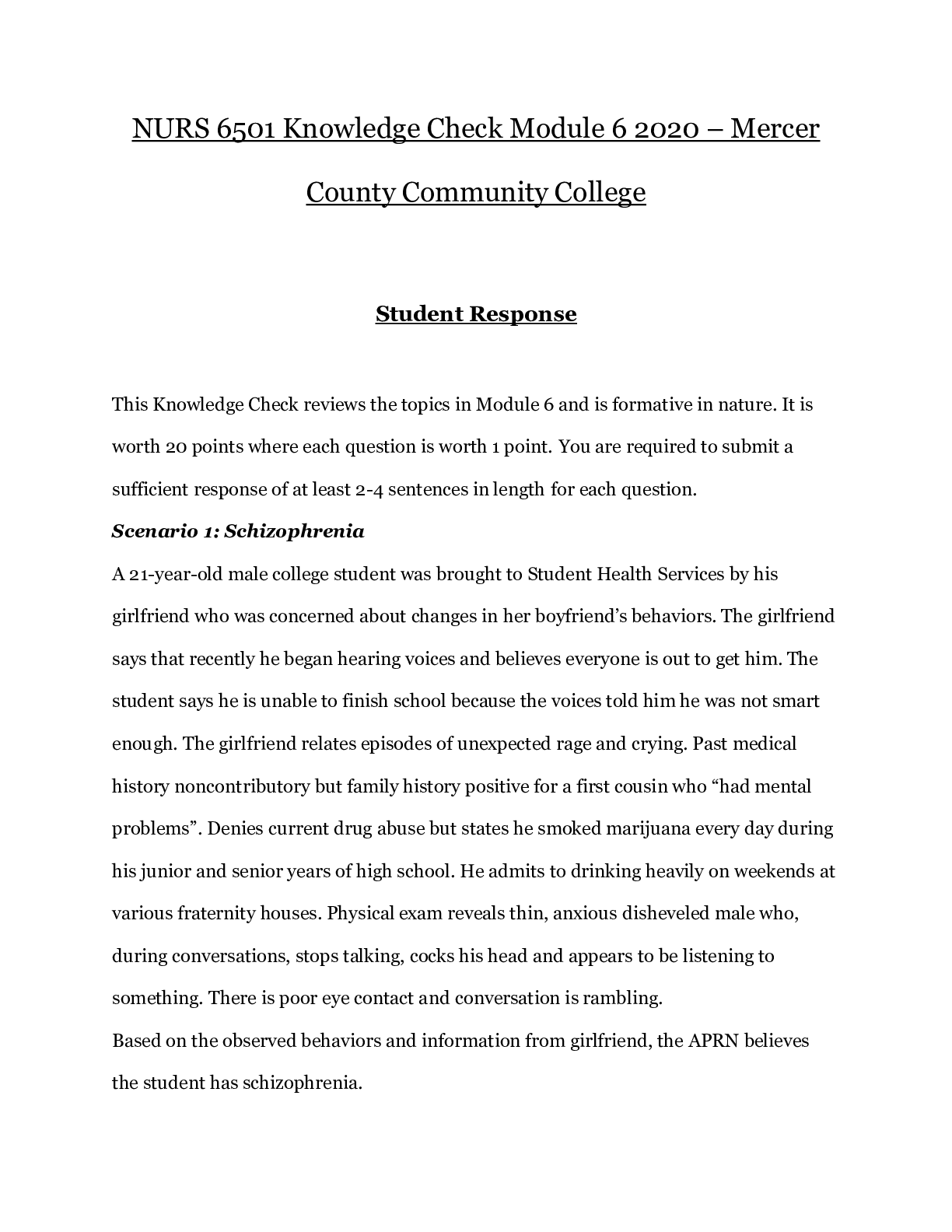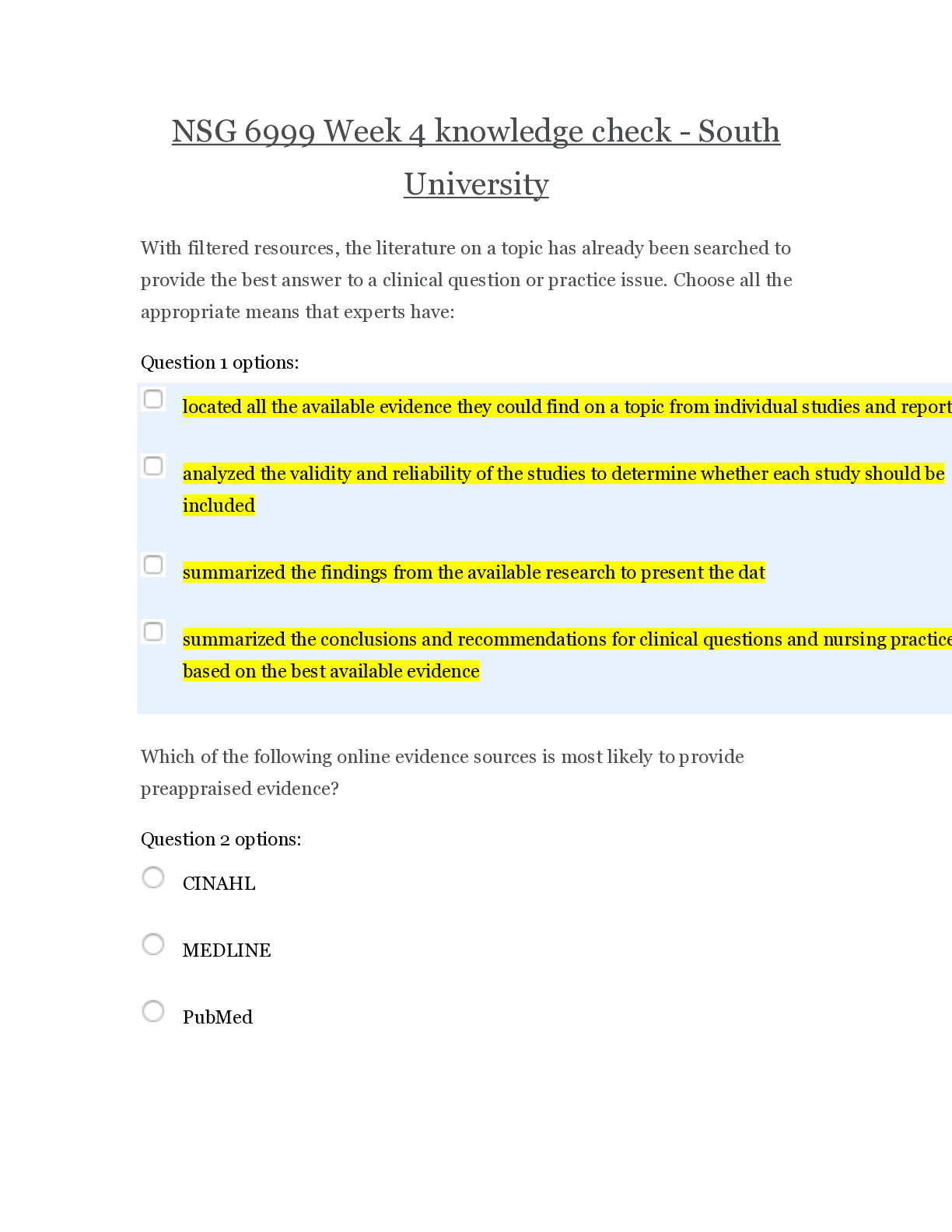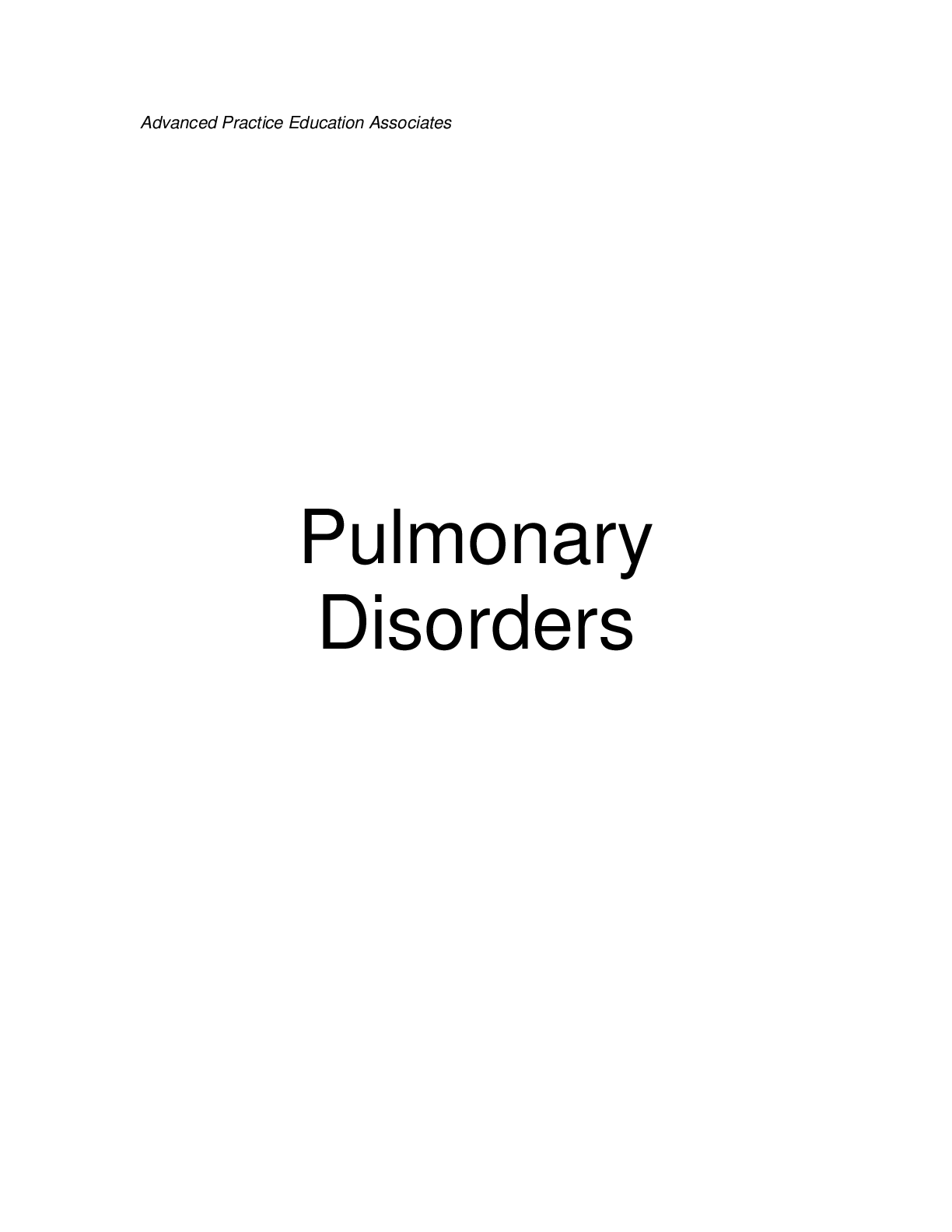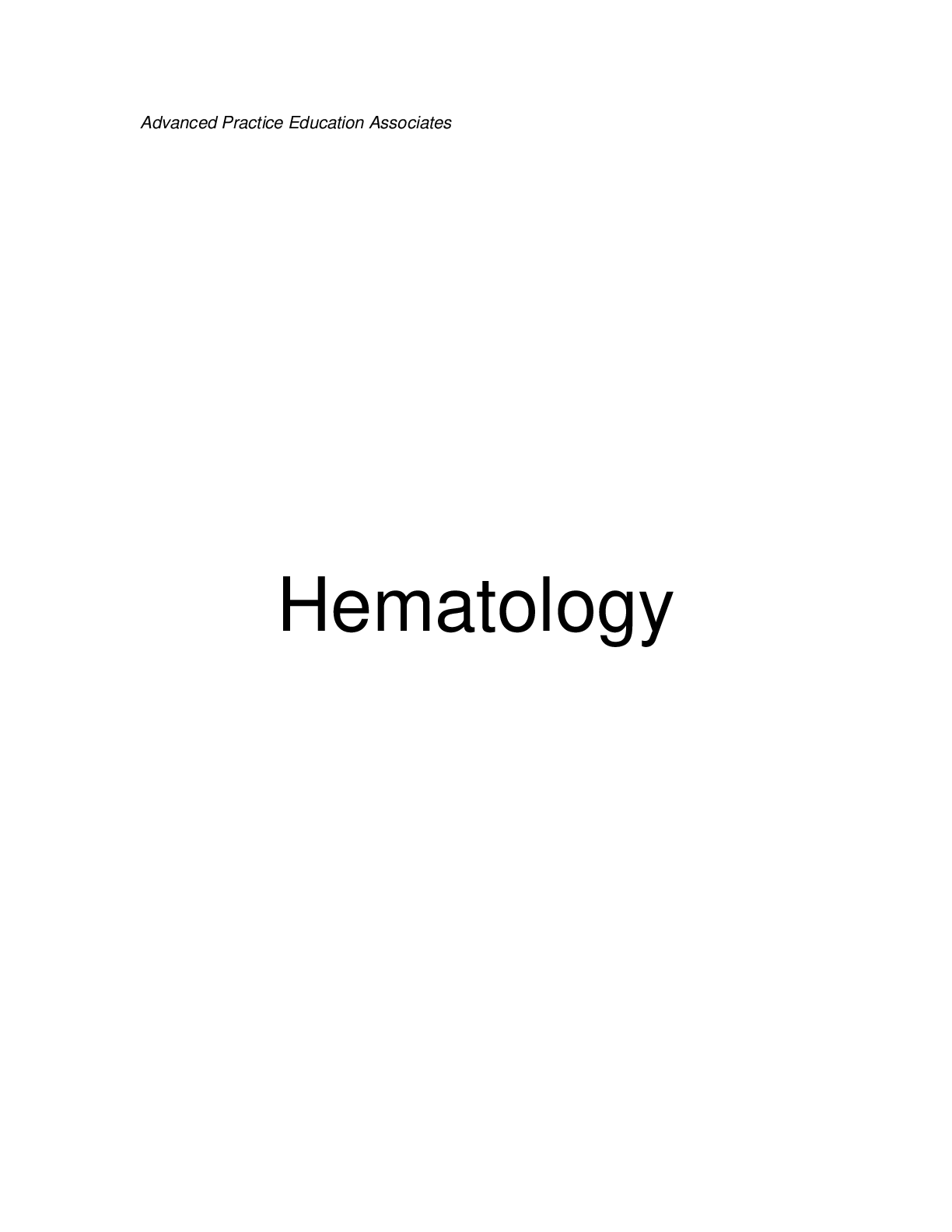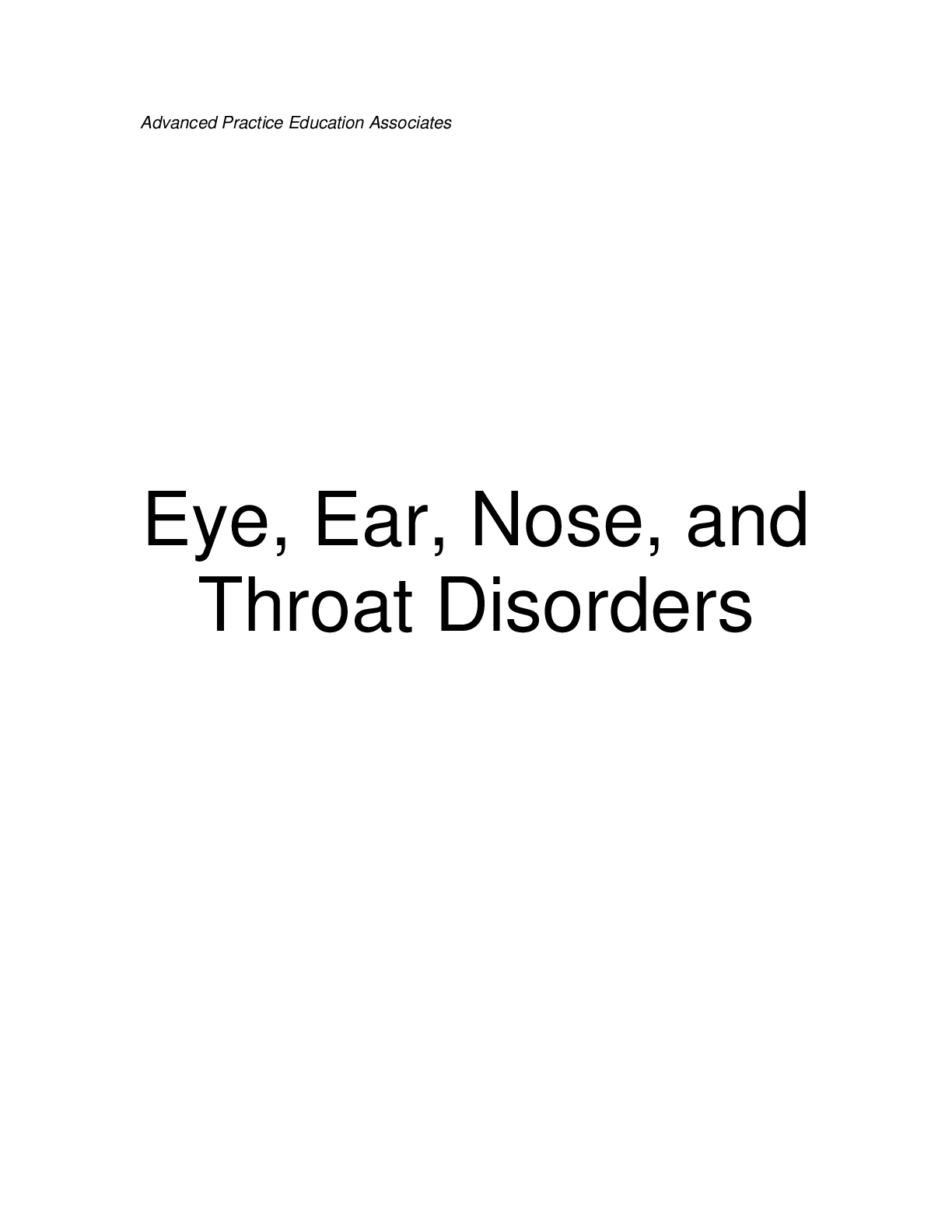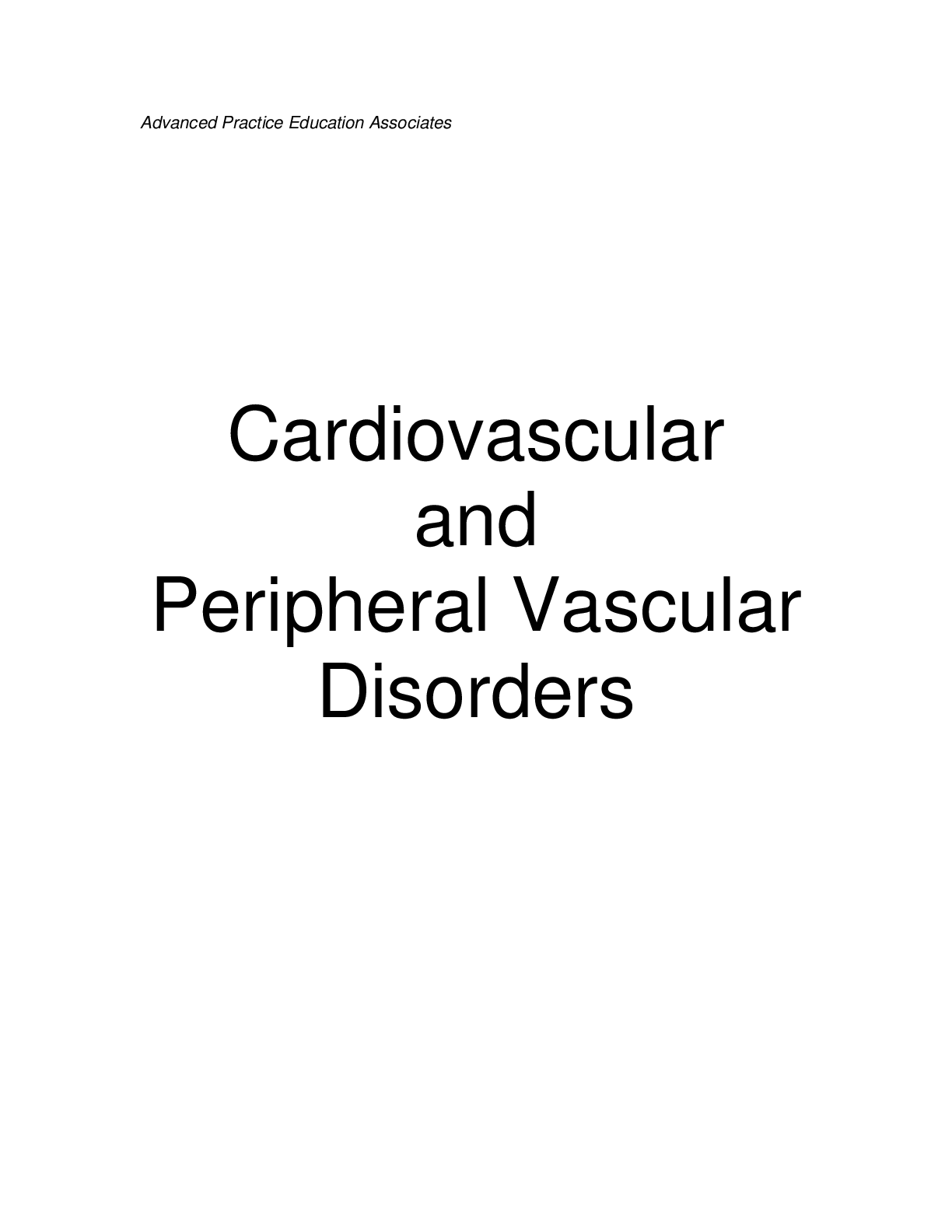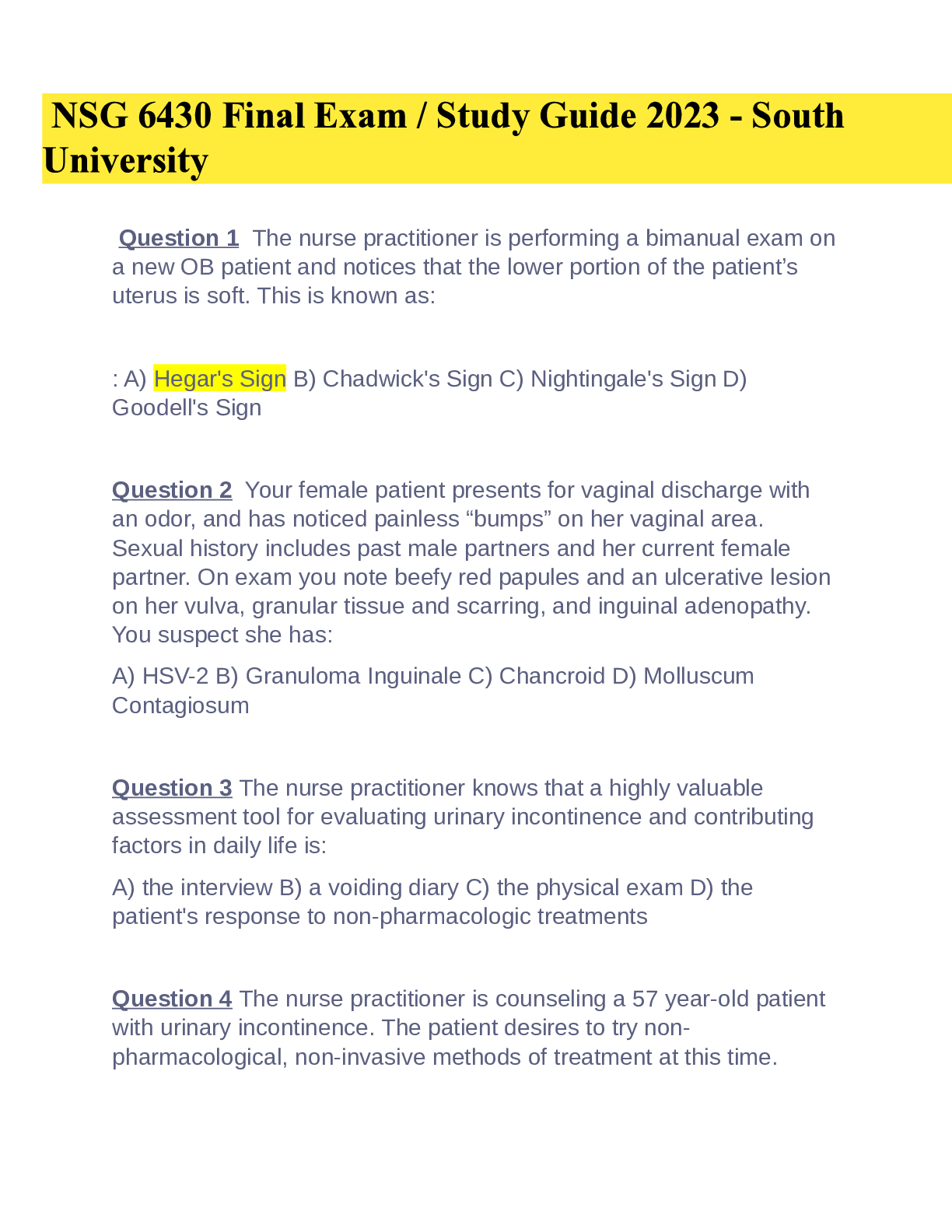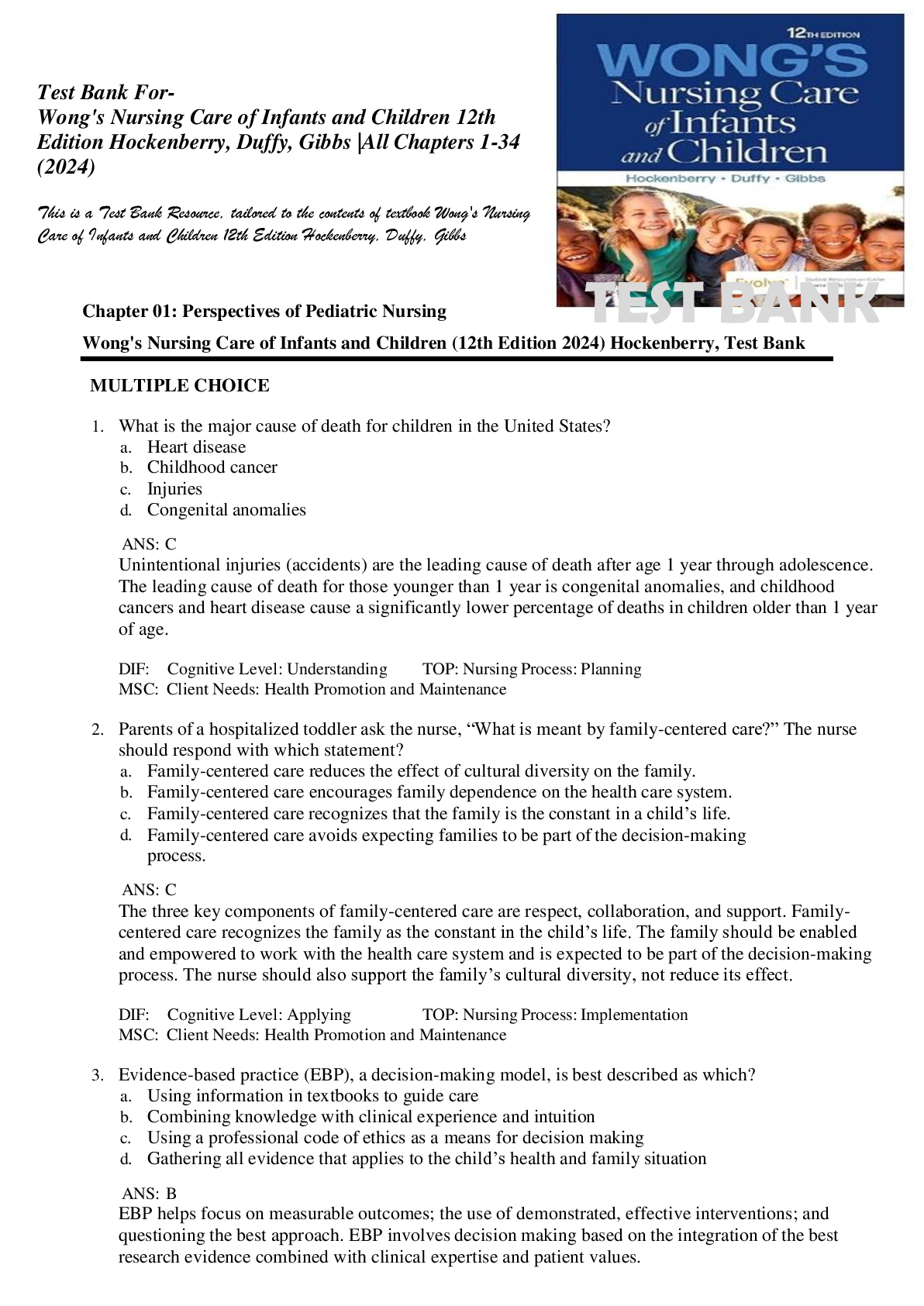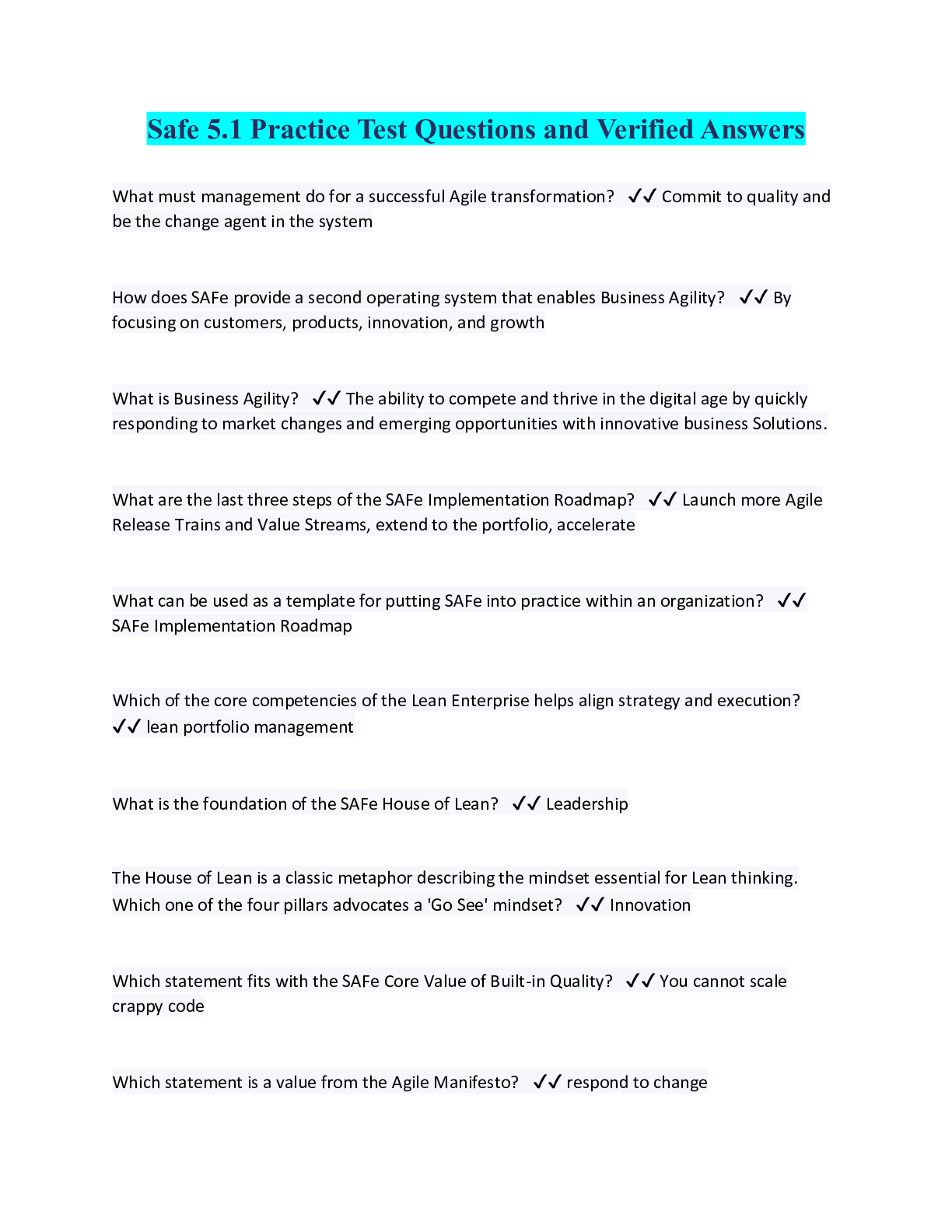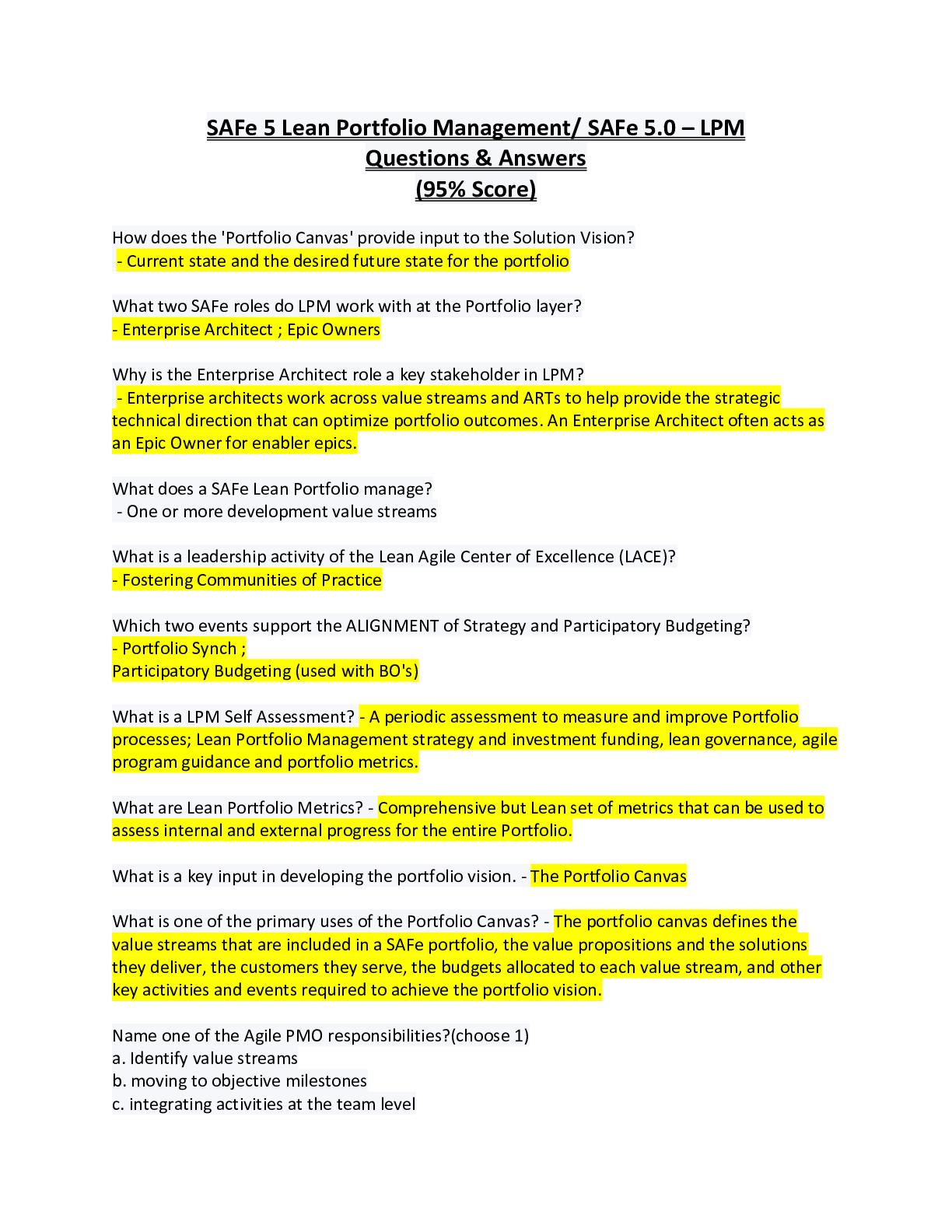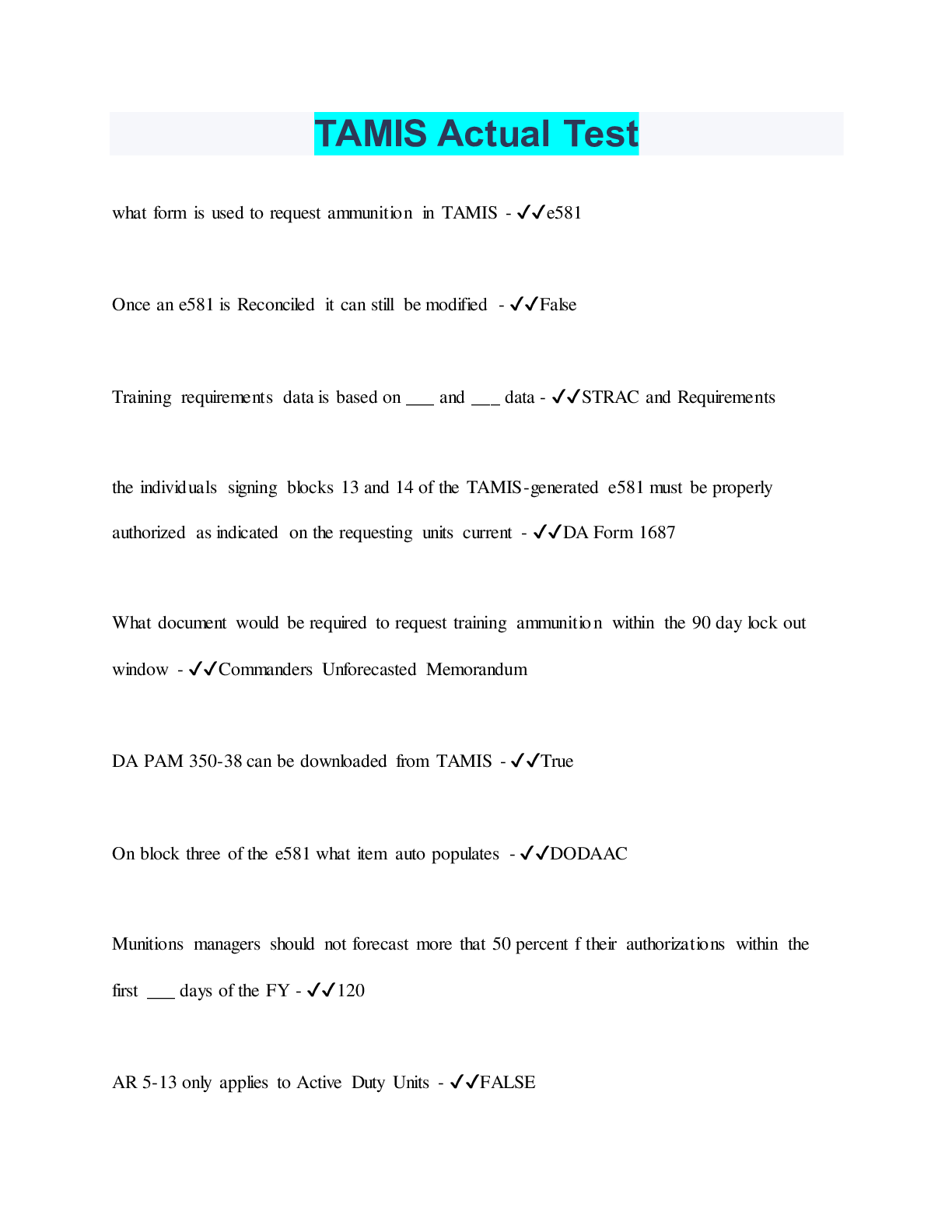*NURSING > EXAM > NSG 6440 APEA Psych Neuro 6020 (2020) - South University / NSG6440 APEA Psych Neuro 6020 (2020) (All)
NSG 6440 APEA Psych Neuro 6020 (2020) - South University / NSG6440 APEA Psych Neuro 6020 (2020)
Document Content and Description Below
NSG 6440 APEA Psych Neuro 6020 (2020) - South University Question: Sudden, brief, rapid jerks, involving the trunk or limbs may be consistent with: a myoclonic seizure. Explanation: A patient... experiencing a myoclonic seizure manifests sudden, brief, rapid jerks, involving the trunk or limbs. A sudden brief lapse of consciousness with momentary blinking, staring, or movements of the lips & hands but no falling is consistent with an absent seizure. During a myoclonic atonic seizure, the patient experiences a sudden loss of consciousness with falling but no movements. Injury may occur. Focal seizures with impairment of consciousness the person appears confused. Automatisms include automatic motor behaviors such as chewing, smacking the lips, walking about, & unbuttoning clothes. Question: During this type of seizure activity, the patient experiences partial seizures that resemble tonic-clonic seizures. The patient may recall the aura and a unilateral neurologic deficit is present during the postictal period. This type of seizure activity is referred to as a: Jacksonian Seizure (tonic & clonic movements that start unilaterally & spread to other parts of the body). Question: An infant presents with an inappropriately increasing head circumference hydrocephalus confirmed by CT Scan. In addition to these findings, which one of the following would also be consistent with hydrocephalus? ?Tense bulging fontanel? Question: The classic signs of a basilar skull fracture include hemotympanum and: CSF leak from nose and ears Question: The cranial sutures are closed on the head of a 9 month old infant. This indicates: Craniosynostosis Question: A patient presents with history of temperature 102 F, HA, and pink papules on the upper chest, etc.. Known about The clinical presentation of meningococcemia may include any of the following: • A nonspecific prodrome of cough, headache, and sore throat • The above followed by a few days of upper respiratory symptoms, increasing temperature, & chills • Subsequent malaise, weakness, myalgias, headache, nausea, vomiting, & arthralgias • The characteristic petechial skin rash is usually located on the trunk & legs & may rapidly evolve into purpura Question: The part of the peripheral nervous system that controls involuntary actions is known as the: autonomic nervous system Explanation: The PNS can be broken down into two systems: the autonomic nervous system, which regulates involuntary actions such as breathing and digestion, and the somatic nervous system, which governs voluntary action and body reflexes. Question: A teenager is being assessed for possible acute marijuana usage and appears intoxicated. Findings consistent with marijuana intoxication could include: Euphoria, talkativeness, and paranoia. Explanation: Marijuana intoxication would present with relaxation, euphoria, detachment, talkativeness, slowed perception of time, & possible anxiety or paranoia. Question: Most peripheral nerves contain afferent and efferent fibers. The term afferent refers to: Sensory nerve fibers. Explanation: Sensory neurons (afferent) – connected to receptors; transmit information to the CNS Question: Which of the following neurological assessment findings indicate the need for further evaluation? Weak & ineffective sucking movements Explanation: Weak & ineffective sucking movements would indicate the need for further evaluation since any weak, absent, asymmetrical or fine jumping movements would suggest neurological system disorders. The other choices represent common reflexes found in the normal newborn: Babinski, grasping, & stepping. Question: An example of proximal weakness is: the right shoulder. Explanation: There are 4 different patterns of weakness: Proximal, distal, symmetric, & asymmetric. An example of proximal weakness is weakness in the shoulder or hip girdle. Distal weakness occurs in the hands or feet. Symmetric weakness occurs in the same areas on both sides of the body. An asymmetric weakness occurs in a portion of the face or extremity - a form of focal weakness. Question: A female patient complains of weakness in her hand when opening a jar. This finding could be suggestive of which type of weakness pattern? Distal Explanation: To identify distal weakness, ask about hand movements when opening a jar, can or using scissors or a screwdriver. Another example is a problems like tripping when walking. Question: A patient presents with an altered level of consciousness. He/she is considered in a stuporous state if he/she: Arouses from sleep after exposure to painful stimuli, exhibits slow verbal responses, & easily lapses into an unresponsive state. Explanation: A stuporous patient arouses from sleep after exposure to painful stimuli, verbal responses are slow, & lapses into an unresponsive state. A lethargic patient appears drowsy but opens the eyes, looks at the examiners, answers the questions, & then falls asleep. An obtunded patient opens the eyes & looks at the examiner, but responds slowly & is somewhat confused. A comatose patient remains unarousable with eyes closed. There is no evident response to inner need or external stimuli. Question: One way to assess cerebellar function would be to have the patient: hop on one foot. Explanation: The cerebellar function tests are used to monitor the patient's sense of equilibrium, which includes the patient's gait (walk), ability to stand upright with eyes closed (Romberg test), touch finger to nose, & move the heel to opposite knee while lying down. Other examples also include: hopping on one foot, walking heel-to-toe, & touching the examiner's finger & the examinees' nose. Reading out loud tests visual acuity; shrugging shoulders assesses the spinal accessory nerve (CN XI) & discriminating pain between light & sharp assesses the sensory system. Question: Hypesthesia refers to: decreased sensitivity to touch. Explanation: Anesthesia is absence of touch sensation; hypesthesia is decreased sensitivity to touch; hyperesthesia is increased sensitivity to touch; & analgesia refers to absence of pain sensation. Question: When conducting a neurologic exam, which one of the following assessments is not considered part of the mental status assessment? Cranial Nerve II (CNII) Explanation: When conducting a neurologic exam, mental status assessment should include evaluation of the level of alertness, appropriateness of responses, & orientation to person, place, & time. Assessing cranial nerve II would be part of the cranial nerve assessment. Question: A mother reports to the nurse practitioner that her teenager might be taking drugs because earlier today the teenager had a mild seizure & now has an unstable gait & is beginning to complain of shortness of breath. These symptoms might be consistent with a possible overdose of: Amphetamines. Explanation: Amphetamines are central nervous system (CNS) stimulants. The teenager could exhibit signs of ataxia, respiratory distress, seizures, coma, myocardial infarction, death if he/she consumed this substance. Impaired memory, judgment, & attention, slurred speech, drowsiness, & irritability are suggestive of central nervous system depressants (CNS). Barbiturates, alcohol & benzodiazepines fall in this class. Opioids may cause euphoria, drowsiness, constricted pupils & some of the same symptoms as CNS depressants. Marijuana intoxication would present with relaxation, euphoria, detachment, talkativeness, slowed perception of time, & possible anxiety or paranoia. Question: An ischemic stroke is: an infarction of the central nervous system tissue that may be silent or symptomatic. Explanation: Ischemic stroke is “an infarction of central nervous system tissue” that may be symptomatic or silent. TIA is now defined as “a transient episode of neurological dysfunction caused by focal brain, spinal cord, or retinal ischemia, without acute infarction.” The other terms are not related to the new definitions. Question: By placing the patient in the supine position, the nurse practitioner raises the patient's relaxed & straightened leg while flexing the leg at the hip, then dorsiflexes the foot. This maneuver is known as: the straight-leg raise. Explanation: By placing the patient in the supine position, the nurse practitioner raises the patient's relaxed & straightened leg while flexing the leg at the hip, then dorsiflexes the foot. This maneuver is known as the straight leg raise & is used to evaluate sciatica. It is positive if there is pain down the back of the leg below the knee. Ipsilateral calf wasting & weak ankle dorsiflexion may be present. Question: The level of consciousness that refers to the patient that appears drowsy but can open his eyes, respond to questions, then fall back to sleep is known as: Lethargy. Explanation: Lethargy refers to the patient that appears drowsy but can open his eyes, respond to questions, then fall back to sleep. An obtunded patient opens his eyes, looks at the person speaking to him but responds slowly & appears confused. The level of consciousness that refers to the ability of the patient to respond fully & appropriately to stimuli is known as alertness. A stuporous patient arouses from sleep only after painful stimuli. Question: When assessing coordination of muscle movement, four areas of the nervous system function in an integrated way. These areas include the motor, cerebellar, the vestibular, & the sensory systems. Which system coordinates a steady posture? Cerebellar system Explanation: Coordination of muscle movement requires that four areas of the nervous system function in an integrated way: motor system for muscle strength, cerebellar system for rhythmic movements & steady posture, vestibular system for balance & coordinating eye, head, & body movements, & sensory system for position sense. Question: An older adult presenting with signs of undernourishment, slowed motor performance, & loss of muscle mass or weakness suggests: Frailty. Explanation: Undernutrition, slowed motor performance, loss of muscle mass, or weakness suggests frailty. Question: Postural tremors appear when the affected part is: is actively maintaining a posture. Explanation: Tremors are rhythmic oscillatory movements. Postural tremors appear when the affected part is actively maintaining a posture. Examples include the fine rapid tremor of hyperthyroidism, the tremors of anxiety & fatigue, & benign essential tremor. The other choices are not consistent with postural tremors. Question: A discriminative sensation that describes the ability to identify an object by feeling it is: stereognosis. Explanation: A discriminative sensation that describes the ability to identify an object by feeling it is stereognosis. The patients eyes must be closed. Graphesthesia, or number identification, is the ability to identify a number when drawn in the hand of a patient whose eyes are closed. The ability to identify an object touching 2 areas simultaneously is termed two-point discrimination. Astereognosis is a term used to describe the inability to recognize objects placed in the hand. Question: When evaluating a patient for weakness of the upper extremities, bilateral distal weakness is noted. This finding could be suggestive of: polyneuropathy. Explanation: Bilateral predominantly distal weakness suggests a polyneuropathy, as in diabetes. Proximal limb weakness, usually symmetric & without sensory loss, occurs in myopathies from alcohol, glucocorticoids, & inflammatory muscle disorders like myositis & dermatomyositis. In the neuromuscular junction disorder myasthenia gravis, there is proximal, typically asymmetric weakness that gets worse with effort. Question: When observing for thenar atrophy of the hands, a typical observation is: furrowing in the spaces between the metacarpals. Explanation: Flattening of the thenar & hypothenar eminences & furrowing between the metacarpals suggests atrophy. Localized atrophy of the thenar & hypothenar eminences suggests damage to the median & ulnar nerves. Normally, the metacarpal spaces are full & slightly depressed & the thenar & hypothenar appear full & convex. Motor neuron disease, rheumatoid arthritis, & protein-calorie malnutrition can cause atrophy in the hand. Question: Fasciculations in atrophic muscles suggest: a lower motor neuron disease. Explanation: Fasciculations are small muscle twitches & can be found in any muscle of the body. Fasciculations are not usually serious but can be annoying. If they occur in atrophic muscles, this may suggest a lower motor neuron disease. They are not seen in central or peripheral nervous system disease or rheumatoid arthritis. Question: The part of the brain that controls most functions in the body & is responsible for breathing, heart rate, & articulate speech is the: Brainstem. Explanation: The nerve connections of the motor & sensory systems from the main part of the brain to the rest of the body pass through the brainstem. The brainstem controls most functions in the body but mostly responsible for breathing, heart rate, & articulate speech. The cerebrum controls all voluntary actions of the body with the aid of the cerebellum. The diencephalon relays sensory information between brain regions & controls many autonomic functions of the peripheral nervous system. It also connects structures of the endocrine system with the nervous system & works in conjunction with limbic system structures to generate & manage emotions & memories. The cerebellum, which lies at the base of the brain, coordinates all movement & helps maintain the body upright in space. Question: Assessing the neurological status of a child with a ventriculoperitoneal shunt should include: Use of the Glasgow coma scale. Explanation: The Glasgow coma scale addresses eye, verbal, & motor responses to determine a neurological assessment score & is the first sign of improvement or deterioration in neurological status. Also, signs of increased intracranial pressure should be assessed. Kernig's sign is any resistance or pain when the child is supine & the leg is extended & knee bent. A positive sign is more consistent with meningitis. Brudzinski's sign is an involuntary flexion of the knee or hip when the child is in the supine position & the neck is flexed & is also consistent with meningitis. The Monroe-Kellie Doctrine states that the sum of brain, CSF, & blood within the cranial vault is constant. So an increase or decrease in one causes a compensatory increase or decrease in one or both of the others. It is an hypothesis & not an assessment. Question: What geriatric condition is characterized by normal alertness but progressive global deterioration of cognition in multiple domains? Alzheimer's disease Explanation: Alzheimer's disease is a geriatric condition in which normal alertness is present but progressive global deterioration of cognition occurs in multiple domains, including short-term memory, but with sparing of memory for remote events, subtle language errors, visuospatial perceptual difficulties, & changes in executive function, or the ability to perform sequential tasks such as instrumental activities of daily living (IADLs). Delirium is a serious disturbance in a person's mental abilities that results in a decreased awareness of one's environment & confused thinking. Cognitive impairment is an intermediate stage between the expected cognitive decline of normal aging & the more serious decline of dementia. Parkinson's disease is a progressive disorder of the nervous system that affects movement. Question: An abnormal or unpleasant sense of touch is termed: dysesthesia. Explanation: An abnormal or unpleasant sense of touch is termed dysesthesia. Dysarthria is the term used to describe difficulty forming words. Paresthesia is a sensation of tingling, tickling, prickling, pricking, or burning of a person's skin. Metatarsalgia is a term used to describe pain & tenderness in the metatarsals. Question: When eliciting deep tendon reflexes in the knee, the nurse practitioner notes an abnormal reflex in the right knee. This abnormality is probably consistent with a pathological lesion in which segmented level of the spine? Lumbar 2, 3, & 4 Explanation: The segmented levels of the deep tendon reflexes are: Ankle: sacral 1; knee: lumbar 2,3, & 4; Supinator & biceps: cervical 5 & 6; & triceps: cervical 6 & 7. Question: When evaluating a patient for weakness of the upper extremities, bilateral proximal limb weakness without sensory loss is noted. This finding could be suggestive of: alcohol myopathy. Explanation: Proximal limb weakness, usually symmetric & without sensory loss, occurs in myopathies from alcohol, glucocorticoids, & inflammatory muscle disorders like myositis & dermatomyositis. Bilateral predominantly distal weakness suggests a polyneuropathy, as in diabetes. In the neuromuscular junction disorder myasthenia gravis, there is proximal, typically asymmetric weakness that gets worse with effort. Question: The term used to describe involuntary muscle spasms & twisting of the limbs is: dystonia. Explanation: Dystonia is a neurological disorder that causes involuntary muscle spasms & twisting of the limbs. Bradykinesia is the term used to describe the impaired ability to adjust to one's body position. This symptom is noted in patients who have Parkinson's disease. The absence or loss of control of voluntary muscle movements is akinesia. Dyskinesia is defined as the presence of involuntary muscle movements such as tics or chorea. These movements can be seen in children who have rheumatic fever. Question: A 40-year-old male presents with complaints of headaches. History reveals headaches that occurred daily for about 4-6 weeks. He had relief for 6 months but now they are recurring. These are most likely: cluster headaches. Explanation: Headaches that are episodic with several each day for 4-6 weeks with an extended period of relief for 6-12 months are most likely cluster headaches. Cluster headaches are more common in men than women. CRITERIA FOR COMMON HEADACHE SYNDROMES Question: Which of the following symptoms may be associated with a tumor of the eighth cranial nerve? Dizziness Explanation: The eighth cranial nerve (CN) is the vestibulocochlear nerve & it is responsible for hearing & balance. The main symptoms of an acoustic neuroma are hearing loss & tinnitus. They are caused by a tumor affecting the auditory nerve. Inability to close the eye would reflect an abnormality of CN VII, the facial nerve. CN I, the olfactory nerve, is responsible for the sense of smell. Two cranial nerves are responsible for the taste, CN VII & X. Question: When trying to determine the level of consciousness in a patient whose level of consciousness is altered, a comatose patient: remains unarousable with eyes closed. Explanation: A comatose patient remains unarousable with eyes closed. There is no evident response to inner need or external stimuli. A lethargic patient appears drowsy but opens the eyes, looks at the examiners, answers the questions, & then falls asleep. An obtunded patient opens the eyes & looks at the examiner, but responds slowly & is somewhat confused. A stuporous patient arouses from sleep after exposure to painful stimuli, verbal responses are slow, & lapses into an unresponsive state. Question: A female patient complaints of weakness in both arms when transferring the wet clothes from the washer & placing them in the dryer. This finding could be suggestive of which type of weakness pattern? Symmetric Explanation: To identify symmetric weakness, ask about experiencing weakness in the same area on both sides of the body. Question: Which developmental area is predominantly affected by lead poisoning? Cognition Explanation: Lead is a naturally-occurring element that can be harmful to humans when ingested or inhaled, particularly to children under the age of 6 years. Lead poisoning can cause a number of adverse human health effects, but is particularly detrimental to the neurological development of children. Question: A form of aphasia in which the person has word-finding difficulties for speaking & writing is known as: Anomic aphasia. Explanation: With anomic aphasia, the person has word-finding difficulties & because of the difficulties, the person struggles to find the right words for speaking & writing. In Broca's aphasia, speech is confluent, slow, with few words & laborious effort. Inflection & articulation are impaired but words are meaningful, with nouns, transitive verbs, & important adjectives. Small grammatical words are often dropped. With Wernicke's aphasia, speech is fluent, often rapid, voluble, & effortless. Inflection & articulation are good, but sentences lack meaning & words are malformed (paraphasias) or invented (neologisms). Speech may be totally incomprehensible. With global aphasia, the person has difficulty speaking & understanding words & is unable to read or write. Question: A patient presents with an altered level of consciousness. He/she is considered in an obtunded state if he/she: opens the eyes & looks at the examiner, but responds slowly & is somewhat confused. Explanation: An obtunded patient opens the eyes & looks at the examiner, but responds slowly & is somewhat confused. A lethargic patient appears drowsy but opens the eyes, looks at the examiners, answers the questions, & then falls asleep. A stuporous patient arouses from sleep after exposure to painful stimuli, verbal responses are slow, & lapses into an unresponsive state. A comatose patient remains unarousable with eyes closed. There is no evident response to inner need or external stimuli. Question: With the patient lying supine, the nurse practitioner places her hands behind the patient's head while flexing his neck forward until his chin touches his chest. Neck stiffness with resistance to flexion is noted. This is a positive: nuchal rigidity sign. Explanation: With the patient lying supine, the nurse practitioner places her hands behind the patient's head while flexing his neck forward until his chin touches his chest. Neck stiffness with resistance to flexion is positive for nuchal rigidity & suggestive of meningeal inflammation from meningitis or subarachnoid hemorrhage. To elicit Brudzinski's sign, flex the neck. Flexion of both the hips & knees is a positive for Brudzinski's sign. To test for Kernig's sign, flex the patient's leg at both the hip & the knee & then straighten the knee. Pain & increased resistance to extending the knee are positive for Kernig's sign. To elicit the Babinski response, stroke the lateral aspect of the sole from the heel to the ball of the foot with the end of an applicator stick, plantar flexion is normal. Dorsiflexion of the big toe is a positive Babinski's sign. Question: Which of the following procedures should NOT be performed in a comatose patient? Check papillary response Explanation: When assessing a comatose patient, the nurse practitioner should not dilate the eyes because pupillary reaction is the single most important clue to the underlying cause of the coma: structural or metabolic. The other procedures can be performed on a comatose patient. Question: The term used to describe a distortion of any sense especially that of touch, is: dysesthesia. Explanation: Dysesthesia is defined as a distortion of any sense, especially that of touch. Absence of sensation is the inability to feel pain or sensation when touched. Weakness is a term used to describe a lack of strength or firmness & its presence requires further investigation. Paresthesia is a sensation of tingling, tickling, prickling, pricking, or burning of a person's skin. Question: Winging of the scapula can be noted in patients with all of the following conditions except: liver disease. Explanation: Normally, the scapulae lie close to the thorax. However, in winging of the scapula the medial border of the scapula juts backward. It suggests weakness of the serratus anterior muscle, seen in muscular dystrophy or injury to the long thoracic nerve. Winging is not characteristic of liver disease. Question: Resting tremors refer to those tremors that disappear: with voluntary movement. Explanation: Tremors are rhythmic oscillatory movements. Resting tremors are most prominent at rest & may decrease or disappear with voluntary movement. These type tremors are characteristic of the patient with Parkinson's disease. The other choices are not consistent with resting tremors. Question: A patient is instructed to stand, close both eyes, & extend both arms forward with the palms facing upward for 20-30 seconds. If the forearm drifts downward, this would indicate: corticospinal tract lesion . Explanation: A patient is instructed to stand, close both eyes, & extend both arms forward with the palms facing upward for 20-30 seconds. If the forearm drifts downward, this would indicate a corticospinal lesion originating in the contralateral hemisphere. An upward drift would be indicative of a lesion in the cerebellum. This test is called the Test for Pronator Drift & is used to test for upper motor neuron disease. Question: A progressive disorder of the nervous system that affects movement is known as: Parkinson's disease. Explanation: Parkinson's disease is a progressive disorder of the nervous system that affects movement. Delirium is a serious disturbance in a person's mental abilities that results in a decreased awareness of one's environment & confused thinking. Cognitive impairment is an intermediate stage between the expected cognitive decline of normal aging & the more serious decline of dementia. Alzheimer's disease is a geriatric condition in which normal alertness is present but progressive global deterioration of cognition occurs in multiple domains, including short-term memory, but with sparing of memory for remote events, subtle language errors, visuospatial perceptual difficulties, & changes in executive function, or the ability to perform sequential tasks such as instrumental activities of daily living (IADLs). Question: While assessing the trigeminal nerve V (CN V) for sensory function, the patient reports a pain sensation on the right cheek. This finding could be consistent with a: cranial nerve disorder. Explanation: While assessing the trigeminal nerve, cranial nerve V (CN V) for sensory function, the patient reports a pain sensation on the right cheek. This finding could be consistent with a cranial nerve disorder, such as trigeminal neuralgia. Question: When assessing the cranial nerves, the nurse practitioner uses the tongue blade to gently stimulate the back of the throat on each side. A unilateral absence of the gag reflex is noted. This finding could be suggestive of a unilateral lesion in which cranial nerve? Cranial Nerve IX (CN IX) Explanation: Unilateral absence of the gag reflex suggests a lesion of CN IX or CN X. glossopharyngeal & vagus nerves. Question: On examination of the adult patient, symptoms of flexed posture, tremor, rigidity, & shuffling gait are observed. These findings are consistent with: Parkinson's disease. Explanation: Evidence of flexed posture, tremor, rigidity, bradykinesia, micrographia, shuffling gait, & difficulty rising from a chair are symptoms consistent with Parkinson's disease. Question: Brief, repetitive, stereotyped, coordinated movements occurring at irregular intervals are consistent with: facial tics. Explanation: Facial tics are brief, repetitive, stereotyped, coordinated movements occurring at irregular intervals. Examples include repetitive winking, grimacing, & shoulder shrugging. Dystonic movements are similar to athetoid movements, but often involve larger portions of the body, including the trunk. Grotesque, twisted postures may result. Athetoid movements are slower & more twisting & writhing than choreiform movements, & have a larger amplitude. They most commonly involve the face & the distal extremities. Oral–facial dyskinesias are rhythmic, repetitive, bizarre movements that chiefly involve the face, mouth, jaw, & tongue: grimacing, pursing of the lips, protrusions of the tongue, opening & closing of the mouth, & deviations of the jaw. These are involuntary movements. Question: A sudden brief lapse of consciousness with momentary blinking, staring, or movements of the lips & hands but no falling is consistent with: an absent seizure. Explanation: A sudden brief lapse of consciousness, with momentary blinking, staring, or movements of the lips & hands but no falling is consistent with an absent seizure. A patient experiencing a myoclonic seizure manifests sudden, brief, rapid jerks, involving the trunk or limbs. During a myoclonic atonic seizure, the patient experiences a sudden loss of consciousness with falling but no movements. Injury may occur. Focal seizures with impairment of consciousness the person appears confused. Automatisms include automatic motor behaviors such as chewing, smacking the lips, walking about, & unbuttoning clothes. https://www.hopkinsmedicine.org/healthlibrary/conditions/adult/nervous_system_disorders/Focal_Seizures_22,FocalSeizures https://epilepsychicago.org/2017/01/04/2017-revised-classification-of-seizures/ Question: Physical exam of a well two-week-old infant reveals a little dimple with a small amount of hair just above the sacral area. This could be: spina bifida occulta. Explanation: There are four types of spina bifida: occulta, closed neural tube defects, meningocele, & myelomeningocele. Occulta is the mildest & most common form in which one or more vertebrae are malformed. The name “occulta,” which means “hidden,” indicates that a layer of skin covers the malformation, or opening in the vertebrae. This form of spina bifida, present in 10-20 percent of the general population, rarely causes disability or symptoms. Closed neural tube defects are often recognized early in life due to an abnormal tuft or clump of hair or a small dimple or birthmark on the skin at the site of the spinal malformation. Meningocele & myelomeningocele generally involve a fluid-filled sac—visible on the back—protruding from the spinal canal. In meningocele, the sac may be covered by a thin layer of skin. In most cases of myelomeningocele, there is no layer of skin covering the sac & an area of abnormally developed spinal cord tissue is usually exposed. Hirsutism is an excessive amount of hair on the body usually caused by a hormonal imbalance. An Arnold-Chiari malformation is a cyst-like formation in the fourth ventricle, cerebellum or brainstem. Question: Persistent blinking after glabellar tap & difficulty walking heel-to- toe are common in: Parkinson’s disease. Explanation: Glabellar tap is a primitive reflex that is characterized by blinking eyes when a patient is lightly tapped between the eyebrows. In less that 5 taps, a normal individual will stop blinking. In Parkinson's disease, persistent blinking will occur until the examiner stops tapping. Difficulty walking heel-to-toe are common in Parkinson's disease. Question: An example of distal weakness is: the right hand. Explanation: There are 4 different patterns of weakness: Proximal, distal, symmetric, & asymmetric. An example of proximal weakness is weakness in the shoulder or hip girdle. Distal weakness occurs in the hands or feet. Symmetric weakness occurs in the same areas on both sides of the body. An asymmetric weakness occurs in a portion of the face or extremity - a form of focal weakness. Question: A teenager presents with signs of being gleeful, somewhat drowsy, & unable to focus. On examination , B/P 90/65, pupils constricted, & speech slurred. These symptoms are consistent with: opioid intoxication. Explanation: Opioid intoxication may cause euphoria, drowsiness, constricted pupils, memory & judgment impairment, & slurred speech. Impaired memory, poor judgment, & inattention, slurred speech, drowsiness, & irritability are suggestive of central nervous system depressants (CNS). Barbiturates, alcohol & benzodiazepines fall in this class. Amphetamines are CNS stimulants. The teenager would exhibit signs of ataxia, respiratory distress, seizures, coma, myocardial infarction, or death. Marijuana intoxication would present with relaxation, euphoria, detachment, talkativeness, slowed perception of time, & possible anxiety or paranoia. Question: An 8-month-old with a significant head lag would suggest the need for: a neurological evaluation. Explanation: A baby typically should be able to control the neck muscles by around 4 months of age, so that when pulling from a lying to a sitting position the head should remain in line with the torso & not flop back. Delays in reaching this developmental milestone have been observed in premature babies & in those with cerebral palsy; all others should be referred to a pediatric neurologist for further evaluation. The other choices do not address the issue or the cause. Early interventions result in better outcomes. Question: Symptoms of a subdural hematoma include: noticeable bleeding between the dura & the cerebrum on X-ray. Explanation: Classic symptoms of subdural hemorrhages include: bleeding between the dura & the cerebrum, retinal hemorrhages, confusion, drowsiness, headaches, & possible seizures. Because this is a slow bleed, symptoms may develop slowly over several days or weeks. Bleeding between the dura & the skull are consistent with epidural bleeds. Question: Assessment findings in an infant with increased intracranial pressure would include: drowsiness. Explanation: Symptoms of increased intracranial pressure in an infant include: drowsiness, separated sutures on the skull, bulging fontanel, & vomiting. Papilledema can be observed in people of any age, but is relatively uncommon in infants because the bones of the skull are not fully fused together at this age. Question: When evaluating the sensory system, testing the posterior columns tract would include assessing sensations of: position & vibration. Explanation: When evaluating the sensory system, testing the spinothalamic tracts would include assessing sensations of pain & temperature. Assessing position & vibration evaluate the posterior columns. Light touch assesses both the spinothalamic & posterior column tracts. To assess discriminative sensation, both the spinothalamic & posterior columns tracts as well as the cortex would be assessed. Question: The term used to describe low back pain with nerve pain that radiates down the leg is: sciatica. Explanation: The term used to describe low back pain with nerve pain that radiates down the leg is sciatica. Asterixis refers to an abnormal tremor consisting of involuntary jerking movements, especially in the hands, frequently occurring with impending hepatic coma & other forms of metabolic encephalopathy. This is also called flapping tremor. A dermatome is a band of skin innervated by the sensory root of a single spinal nerve. Stereognosis refers to the ability to identify an object by feeling it. Question: A form of aphasia in which the speech is confluent, slow, with few words & laborious effort & inflection & articulation are impaired but words are meaningful, is termed: Broca's aphasia. Explanation: In Broca's aphasia, speech is confluent, slow, with few words & laborious effort. Inflection & articulation are impaired but words are meaningful, with nouns, transitive verbs, & important adjectives. Small grammatical words are often dropped. With anomic aphasia, the person has word-finding difficulties & because of the difficulties, the person struggles to find the right words for speaking & writing. With Wernicke's aphasia, speech is fluent, often rapid, voluble, & effortless. Inflection & articulation are good, but sentences lack meaning & words are malformed (paraphasias) or invented (neologisms). Speech may be totally incomprehensible. With global aphasia, the person has difficulty speaking & understanding words & is unable to read or write. Question: Symmetric weakness of the distal muscles of the legs suggests a: polyneuropathy. Explanation: Polyneuropathy would present as symmetric weakness in the distal muscles. Symmetric weakness of the proximal muscles of the legs suggests a myopathy. Nystagmus, dysarthria, hypotonia, & ataxia would be characteristic of cerebellar disease. Sensory neuropathy usually presents as numbness, tingling, & pain. Question: Symmetric weakness of the proximal muscles of the legs suggests a: myopathy. Explanation: Symmetric weakness of the proximal muscles of the legs suggests a myopathy. Polyneuropathy would exhibit symptoms of symmetric weakness in the distal muscles. Nystagmus, dysarthria, hypotonia, & ataxia would be characteristic of cerebellar disease. Sensory neuropathy usually presents as numbness, tingling, & pain. Question: Dysarthria refers to: a defect in the muscular control of the speech apparatus. Explanation: Dysarthria refers to a defect in the muscular control of the speech apparatus (lips, tongue, palate, or pharynx). Dysphonia refers to less severe impairment in the volume, quality, or pitch of the voice. Aphonia refers to a loss of voice that accompanies disease affecting the larynx or its nerve supply. Aphasia refers to a disorder in producing or understanding language. Question: Walking on the toes & heels may reveal: distal muscular weakness in the legs. Explanation: Walking on the toes & heels may reveal distal muscular weakness in the legs. Inability to heel-walk is a sensitive test for corticospinal tract weakness. An ataxia would be suspected if the patient was unable to walk heel-to-toe in a straight line. Inability to hop in place on each foot would denote cerebellar dysfunction. Difficulty performing a shallow knee bend would suggest proximal weakness in the extensors of the hip, weakness of the quadriceps, extensors of the knee, or both. Question: When upper motor neuron systems are damaged above the crossover of its tracts in the medulla, motor impairment develops on the opposite side. This term is: contralateral. Explanation: When upper motor neuron systems are damaged above the crossover of its tracts in the medulla, motor impairment develops on the opposite side. This term is contralateral. In damage below the crossover, motor impairment would occur on the same side or ipsilateral side. Superficial refers to the outer surface of something. Intermediate is a term used to denote something between two other structures. Question: An infant with fetal alcohol syndrome would: be irritable, hyperactive & exhibit a high-pitched cry. Explanation: A baby with fetal alcohol syndrome may have the following symptoms: poor intrauterine growth, delayed growth after birth, decreased muscle tone & poor coordination, delayed development & problems in three or more major areas: thinking, speech, movement, or social skills; heart defects; structural problems of the face; irritability, hyperactive & a high-pitched cry. The other symptoms are not consistent with fetal alcohol syndrome. Question: Involuntary movements of the body that are slower & more twisting & writhing than choreiform movements, & have a larger amplitude are suggestive of: athetoid movements. Explanation: Athetoid movements are slower & more twisting & writhing than choreiform movements, & have a larger amplitude. They most commonly involve the face & the distal extremities. Facial tics are brief, repetitive, stereotyped, coordinated movements occurring at irregular intervals. Examples include repetitive winking, grimacing, & shoulder shrugging. Dystonic movements are similar to athetoid movements, but often involve larger portions of the body, including the trunk. Grotesque, twisted postures may result. Oral–facial dyskinesias are rhythmic, repetitive, bizarre movements that chiefly involve the face, mouth, jaw, & tongue: grimacing, pursing of the lips, protrusions of the tongue, opening & closing of the mouth, & deviations of the jaw. These are involuntary movements. Question: An example of symmetric weakness is: both arms. Explanation: There are 4 different patterns of weakness: Proximal, distal, symmetric, & asymmetric. An example of proximal weakness is weakness in the shoulder or hip girdle. Distal weakness occurs in the hands or feet. Symmetric weakness occurs in the same areas on both sides of the body. An asymmetric weakness occurs in a portion of the face or extremity - a form of focal weakness. Question: Anesthesia refers to: absence of touch sensation. Explanation: Analgesia refers to absence of pain sensation; hypalgesia to decreased sensitivity to pain; hyperalgesia to increased sensitivity; & anesthesia to absence of touch sensation. Question: When assessing an elderly patient for delirium, the recommended instrument with the best supportive data is the: Confusion Assessment Method (CAM). Explanation: Confusion Assessment Method (CAM), a screening tool specifically designed to detect delirium, is the most recommended because it provides the best supportive data for bedside use & takes 5 minutes to complete. The Delirium Rating Scale (DRS) covers a range of symptoms relating to delirium, & is useful for diagnostic purposes & for assessing severity & distinguishing delirium from other disorders. It is very complex & requires advanced training to administer. The MMSE is the most widely used instrument to test cognitive function. The Delirium Superimposed on Dementia Algorithm recommends a process to assess for delirium for people with a pre-existing dementia. Question: An indication that there is a malfunction of a ventriculoperitoneal (VP) shunt in an older child would be the presence of a: headache upon awakening. Explanation: Headache & projectile vomiting are associated with shunt malfunction as well as signs of increased intracranial pressure. Fever can be associated with shunt infection. Older children's fontanels & sutures are closed, so they do not present with bulging fontanels. Question: When assessing abdominal cutaneous reflexes, the nurse practitioner strokes the lower abdomen, the localized twitch is absent. This finding could be suggestive of a pathologic lesion in which segmented level of the spine? Thoracic 10, 11, & 12 Explanation: Superficial (cutaneous) reflexes & their corresponding spinal segments include the following: Abdominal reflexes: upper thoracic 8, 9, 10 & lower thoracic 10, 11, 12; Plantar: lumbar 5 & sacral 1; & Anal: sacral 2, 3, 4. Question: While assessing the cranial nerves, the nurse practitioner touches the cornea lightly with a wisp of cotton. This maneuver assesses which cranial nerve? Cranial Nerve V (CN V) Explanation: Touching the cornea & assessing for a reflex assesses cranial nerve V. Question: The level of consciousness that refers to the patient that arouses from sleep only after painful stimuli is known as: stupor. Explanation: A stuporous patient arouses from sleep only after painful stimuli. An obtunded patient opens his eyes, looks at the person speaking to him but responds slowly & appears confused. The level of consciousness that refers to the ability of the patient to respond fully & appropriately to stimuli is known as alertness. Lethargy refers to the patient that appears drowsy but can open his eyes, respond to questions, then fall back to sleep. Question: When evaluating the sensory system, testing the spinothalamic tracts would include assessing sensations of: pain & temperature. Explanation: When evaluating the sensory system, testing the spinothalamic tracts would include assessing sensations of pain & temperature. Assessing position & vibration evaluate the posterior columns. Light touch assesses both the spinothalamic & posterior column tracts. To assess discriminative sensation, both the spinothalamic & posterior columns tracts as well as the cortex would be assessed. Question: Hypalgesia refers to: decreased sensitivity to pain. Explanation: Analgesia refers to absence of pain sensation; hypalgesia to decreased sensitivity to pain; hyperalgesia to increased sensitivity; & anesthesia to absence of touch sensation. Question: Which choice is least likely to be an example of asymmetric weakness? Both arms Explanation: There are 4 different patterns of weakness: Proximal, distal, symmetric, & asymmetric. An example of proximal weakness is weakness in the shoulder or hip girdle. Distal weakness occurs in the hands or feet. Symmetric weakness occurs in the same areas on both sides of the body. An asymmetric weakness occurs in a portion of the face or extremity - a form of focal weakness. Question: When assessing coordination of muscle movement, four areas of the nervous system function in an integrated way. These areas include the motor, cerebellar, the vestibular, & the sensory systems. Which system coordinates head movements? Vestibular system Explanation: Coordination of muscle movement requires that four areas of the nervous system function in an integrated way: motor system for muscle strength, cerebellar system for rhythmic movements & steady posture, vestibular system for balance & coordinating eye, head, & body movements, & sensory system for position sense. Question: When comparing two sides of the body for symmetric sensation a symmetrical distal sensory loss would be suggestive of: polyneuropathy. Explanation: When comparing two sides of the body for symmetric sensation a symmetrical distal sensory loss would be suggestive of polyneuropathy. A hemisensory loss pattern would suggest a lesion in the opposite cerebral hemisphere. Spinal cord lesions would present with sensory loss from tract damage below the level of the lesion. A peripheral lesion with sensory loss would present with a stocking - glove distribution. Question: A 80 year old male visits the nurse practitioner for an annual well exam. History reveals two falls in the prior 12 months & difficulty with balance. The next step the nurse practitioner should take is: obtain cognitive & functional assessment. Explanation: High-risk older adults, namely those with a single fall in the past 12 months with abnormal gait & balance & those with two or more falls in the prior 12 months, an acute fall, &/or difficulties with gait & balance, require further assessment to determine the reasons for the falls. Obtaining relevant medical history, physical exam, cognitive & functional assessment & determining multifactorial fall risks are essential to the preventing future falls. Question: The principal muscles involved when closing the mouth are innervated by which Cranial nerve? Cranial Nerve V (CN V) Explanation: The muscles responsible for closing the mouth are innervated by Cranial nerve V (trigeminal nerve). Cranial nerve V innervates the masseter, the temporalis, & the internal pterygoids. Question: The best method of detecting cognitive impairment or mental retardation at an early age is by: assessment of the achievement of developmental milestones. Explanation: The least invasive, least expensive, most efficient strategy used to detect cognitive & developmental deficits in infants & children is assessing for achievement of developmental milestones. Delay in achievement of developmental milestones is a cardinal sign of deficits/disabilities. The other three choices may be done at a later date as the child gets older & after the child is identified as having delayed or failure to achieve milestones. Question: When trying to determine the level of consciousness in a patient whose level of consciousness is altered, a lethargic patient: appears drowsy but opens the eyes, looks at the examiners, answers the questions, & then falls asleep. Explanation: A lethargic patient appears drowsy but opens his eyes, looks at the examiners, answers the questions, & then falls asleep. An obtunded patient opens the eyes & looks at the examiner, but responds slowly & is somewhat confused. A stuporous patient arouses from sleep after exposure to painful stimuli, exhibits slow verbal responses, & easily lapses into an unresponsive state. A comatose patient remains unarousable with eyes closed. There is no evident response to inner need or external stimuli. Question: When eliciting deep tendon reflexes in the ankle, the nurse practitioner notes an abnormal reflex in the right ankle. This abnormality is probably consistent with a pathological lesion in which segmented level of the spine? Sacral 1 Explanation: The segmented levels of the deep tendon reflexes are: Ankle: sacral 1; knee: lumbar 2,3, & 4; Supinator & biceps: cervical 5 & 6; & triceps: cervical 6 & 7. Question: The term used to describe the absence or loss of control of voluntary muscle movements is: akinesia. Explanation: The absence or loss of control of voluntary muscle movements is akinesia. Dystonia is a neurological disorder that causes involuntary muscle spasms & twisting of the limbs. Bradykinesia is the term used to describe the impaired ability to adjust to one's body position. This symptom is noted in patients who have Parkinson's disease. Dyskinesia is the presence of involuntary muscle movements such as tics or chorea. These movements can be seen in children who have rheumatic fever. Question: With the adult patient lying supine, the nurse practitioner strokes the lateral aspect of the sole from the heel to the ball of the foot with the end of an applicator stick. Dorsiflexion of the big toe was noted. This is a positive: Babinski's sign. Explanation: To elicit Babinski sign, stroke the lateral aspect of the sole from the heel to the ball of the foot with the end of an applicator stick. Plantar flexion is normal. Dorsiflexion of the big toe is a positive Babinski's sign. To elicit Brudzinski's sign, flex the neck. Flexion of both the hips & knees is positive for Brudzinski's. To test for Kernig's sign, flex the patient's leg at both the hip & the knee & then straighten the knee. Pain & increased resistance to extending the knee are positive for a Kernig's sign. With the patient lying supine, the nurse practitioner places her hands behind the patient's head while flexing his neck forward until his chin touches his chest. Neck stiffness with resistance to flexion is noted. This is positive nuchal rigidity & suggestive of meningeal inflammation from meningitis or subarachnoid hemorrhage. Question: The part of the peripheral nervous system that regulates muscle movement & response to the sensations of pain & touch is the: somatic nervous system. Explanation: The part of the peripheral nervous system that regulates muscle movement & response to the sensations of pain & touch is the somatic nervous system. The autonomic nervous system generates autonomic reflex responses & consists of the sympathetic & parasympathetic nervous systems. The sympathetic nervous system mobilizes organs & their functions during times of stress & arousal. The parasympathetic nervous system conserves energy & resources during times of rest & relaxation. Question: The part of the brain that coordinates all movement & helps maintain the body upright in space is the: cerebellum. Explanation: The cerebellum, which lies at the base of the brain, coordinates all movement & helps maintain the body upright in space. The cerebrum controls all voluntary actions of the body with the aid of the cerebellum. The nerve connections of the motor & sensory systems from the main part of the brain to the rest of the body pass through the brainstem. Brainstem controls most functions in the body but mostly responsible for breathing, heart rate, & articulate speech. The diencephalon relays sensory information between brain regions & controls many autonomic functions of the peripheral nervous system. It also connects structures of the endocrine system with the nervous system & works in conjunction with limbic system structures to generate & manage emotions & memories. Question: The part of the brain tissue that consists of neuronal axons that are coated with myelin is the: white matter. Explanation: Brain tissue may be gray or white. Gray matter consists of aggregations of neuronal cell bodies. It rims the surfaces of the cerebral hemispheres, forming the cerebral cortex. White matter consists of neuronal axons that are coated with myelin. The myelin sheaths, which create the white color, allow nerve impulses to travel more rapidly. Question: A patient complains of experiencing symptoms of nausea, diaphoresis, & pallor triggered by a fearful or unpleasant event. These symptoms are most likely associated with: vasovagal syncope. Explanation: In vasovagal syncope, a common cause of syncope, a prodrome of nausea, diaphoresis, & pallor are triggered by a fearful or unpleasant event, then vagally mediated hypotension, often with slow onset & offset. In syncope from arrhythmias, onset & offset are often sudden, reflecting loss & recovery of cerebral perfusion. Stroke or subarachnoid hemorrhage are unlikely to cause syncope unless there are focal findings & damage to both hemispheres. Question: The patient has his eyes closed & an area on his right leg is briefly touched by the nurse practitioner. The patient is instructed to open his eyes & point to the area that was touched. This is an example of the discriminative sensation known as: point localization. Explanation: Graphesthesia, or number identification is the ability to identify a number when drawn in the hand of a patient whose eyes are closed. A discriminative sensation, stereognosis, is the ability to identify an object by feeling. The ability to identify an object touching 2 areas simultaneously is termed two-point discrimination. Point localization refers to the ability of the patient to identify the area of the body that was touched when his eyes were closed. Question: Hyperesthesia refers to: increased sensitivity to touch. Explanation: Anesthesia is absence of touch sensation; hypesthesia is decreased sensitivity to touch; hyperesthesia is increased sensitivity to touch; & analgesia refers to absence of pain sensation. Question: A patient who is being evaluated for frequent headaches, mentions that the headache worsens with coughing, sneezing, or when changing positions. Increasing pain with these maneuvers may be suggestive of: a brain tumor. Explanation: If coughing, sneezing, or changing positions increases the pain associated with the headache, sinusitis or a brain tumor may be considered. Migraines may present with symptoms of nausea & vomiting. Brain tumors & subarachnoid hemorrhages can also present with nausea & vomiting. Question: The term used to describe an abnormal tremor consisting of involuntary jerking movements, especially in the hands is: asterixis. Explanation: Asterixis refers to an abnormal tremor consisting of involuntary jerking movements, especially in the hands, frequently occurring with impending hepatic coma & other forms of metabolic encephalopathy. This is also called flapping tremor. The term used to describe low back pain with nerve pain that radiates down the leg is sciatica. A dermatome is a band of skin innervated by the sensory root of a single spinal nerve. Stereognosis refers to the ability to identify an object by feeling it. Question: Which one of the following assesses pain, temperature, & sensation using the distal & proximal areas testing pattern? Test the sensation in the thumbs & little fingers Explanation: When testing pain, temperature, & touch sensation, also compare the distal with the proximal areas of the extremities. Further, scatter the stimuli so as to sample most of the dermatomes & major peripheral nerves. An example would be to test the thumbs & fingers (C6 & C8). Comparing the sensation in the right arm with that in the left arm would be an example of the testing pattern of comparing symmetric areas. Testing the fingers & toes is an example of testing pattern for vibration & position sense. By stimulating an area of reduced sensation & moving by progressive steps until the patient detects a change is an example of the pattern of mapping out the boundaries for sensory loss. Question: The part of the brain that maintains homeostasis is the: hypothalamus. Explanation: The hypothalamus maintains homeostasis & regulates temperature, heart rate, & blood pressure. The hypothalamus affects the endocrine system & governs emotional behaviors such as anger & sexual drive. Hormones secreted in the hypothalamus act directly on the pituitary gland. Question: An example of tandem walking is having the patient: walk heel-to-toe. Explanation: Walking heel-to-toe in a straight line is called tandem walking. If the patient is unable to accomplish this, it may reveal ataxia. The other examples are not examples of tandem walking. Question: The central nervous system extends from the medulla into the: Spinal cord. Explanation: Below the medulla, the central nervous system extends into the elongated spinal cord, encased within the bony vertebral column & terminating at the first or second lumbar vertebra. Question: A patient is unable to identify the smell of an orange. This inability could reflect an abnormality in cranial nerves: I Explanation: Cranial Nerve I is the olfactory nerve responsible for the sense of smell. To test the sense of smell, the examiner presents the patient with familiar & nonirritating odors. A person should normally perceive odor on each side & ly identify the source. Cranial Nerves II & III assess vision & pupillary reaction. Cranial Nerve VIII tests the hearing & balance. Question: When assessing the patient's sense of position, instruct the patient to first stand with his feet together & eyes open, then instruct him to close both eyes for 30-60 seconds. If he loses his balance with his eyes closed, this is: suggestive of ataxia related to dorsal column disease. Explanation: When assessing the patient's sense of position, instruct the patient to first stand with his feet together & eyes open, then instruct him to close both eyes for 30-60 seconds. If he loses his balance with his eyes closed, this is a positive Romberg test & suggestive of ataxia related to a dorsal column disease. In cerebellar ataxia, the patient has difficulty standing with feet together whether the eyes are open or closed. With corticospinal tract damage, the gait is affected & the patient is unable to heel-walk. Question: When evaluating the six cardinal directions of gaze, a loss of conjugate movements is noted when the patient looks to his left. This finding could be consistent with damage to which cranial nerve? Cranial Nerve IV (CN IV) Explanation: To evaluate the extraocular movements in the six cardinal directions of gaze, the examiner should look for loss of conjugate movements in any of the six directions. If there is discongruent gaze, this could be suggestive of damage to cranial nerves CN III, IV, & VI - Oculomotor, Trochlear, & Abducens nerves. Question: Dysarthria refers to: a defect in the muscular control of the speech apparatus. Explanation: Dysarthria refers to a defect in the muscular control of the speech apparatus (lips, tongue, palate, or pharynx). Dysphonia refers to less severe impairment in the volume, quality, or pitch of the voice. Aphonia refers to a loss of voice that accompanies disease affecting the larynx or its nerve supply. Aphasia refers to a disorder in producing or understanding language. Question: Disorders of speech fall into three groups that affect all of the following except the: written language. Explanation: Disorders of speech fall into three groups affecting: (1) the voice, (2) the articulation of words, & (3) the production & comprehension of language. The written language is not included in the disorders of speech. Question: Unilateral weakness in cranial nerve V (CN V) would be suggestive of a: pontine lesion. Explanation: Unilateral weakness in cranial nerve V (CN V), the trigeminal nerve, is suggestive of a pontine lesion (located in the pons). Question: The most common cause of viral encephalitis in children is: Herpes simplex virus Type I. Explanation: Herpes simplex Type I is the most common cause of viral encephalitis in children. The other choices are in. Question: The principal muscles involved when closing the mouth are innervated by which Cranial nerve? Cranial nerve V (CN V) Explanation: The muscles responsible for closing the mouth are innervated by Cranial nerve V (trigeminal nerve). Cranial nerve V innervates the masseter, the temporalis, & the internal pterygoids. Question: Left eye ptosis: Cranial Nerve III Question: Intention tremors appear with movement &: worsen as the target gets closer. Explanation: Tremors are rhythmic oscillatory movements. Intention tremors, absent at rest, appear with movement & often worsen as the target gets closer. Causes include disorders of cerebellar pathways, as in multiple sclerosis, or any other disease of the cerebellum. The other choices are not consistent with intention tremors. Question: When assessing coordination of muscle movement, four areas of the nervous system function in an integrated way. These areas include the motor, cerebellar, the vestibular, & the sensory systems. Which system coordinates a steady posture? Cerebellar system. Explanation: Coordination of muscle movement requires that four areas of the nervous system function in an integrated way: motor system for muscle strength, cerebellar system for rhythmic movements & steady posture, vestibular system for balance & coordinating eye, head, & body movements, & sensory system for position sense. Question: Sudden, brief, rapid jerks, involving the trunk or limbs may be consistent with: a myoclonic seizure. Explanation: A patient experiencing a myoclonic seizure manifests sudden, brief, rapid jerks, involving the trunk or limbs. A sudden brief lapse of consciousness with momentary blinking, staring, or movements of the lips & hands but no falling is consistent with an absent seizure. During a myoclonic atonic seizure, the patient experiences a sudden loss of consciousness with falling but no movements. Injury may occur. Focal seizures with impairment of consciousness the person appears confused. Automatisms include automatic motor behaviors such as chewing, smacking the lips, walking about, & unbuttoning clothes. Question: A patient experiences difficulty rising from a sitting position without arm support. This would be suggestive of: Proximal muscle weakness of the pelvic girdle & legs. Explanation: A patient who experiences difficulty rising from a sitting position without arm support or is unable to step up on a sturdy stool without support suggests proximal muscle weakness of the pelvic girdle & legs. Question: Common physical findings in a young child with cerebral palsy include which one of the following? Presence of crossed or touching knees Explanation: Cerebral palsy (CP) is a group of disorders that can involve the brain & nervous system functions, such as movement, learning, hearing, seeing, & thinking. There are several different types of cerebral palsy, including spastic, dyskinetic, ataxic, hypotonic, & mixed. Symptoms usually depend on the type & can be seen before a child is 2 years old, & sometimes as early as 3 months. Symptoms may include delays in reaching & in developmental stages such as sitting, rolling, crawling, or walking, or abnormal gait. Arms may be tucked in toward the sides, knees may be crossed or touching, legs may make "scissor" movements, & child may walk on toes. Additionally, newborn reflexes may persist beyond the expected time frame for their disappearance. Question: A teenager is being assessed for possible acute marijuana usage & appears intoxicated. Findings consistent with marijuana intoxication could include: euphoria, talkativeness, & paranoia. Explanation: Marijuana intoxication could present with euphoria, detachment, talkativeness, slowed perception of time, & possible anxiety or paranoia. Amphetamines are CNS stimulants & the teenager could exhibit signs of ataxia, respiratory distress, seizures, coma, myocardial infarction, or death. Opioids may cause euphoria, drowsiness, constricted pupils & similar same symptoms as CNS depressants. Impaired memory, judgment, attention, slurred speech, drowsiness, & irritability are suggestive of central nervous system depressants (CNS). Barbiturates, alcohol & benzodiazepines fall in this class. Question: When eliciting deep tendon reflexes in the triceps, the nurse practitioner notes an abnormal reflex in the right triceps. This abnormality is probably consistent with a pathological lesion in which segmented level of the spine? Cervical 6 & 7 Explanation: The segmented levels of the deep tendon reflexes are: Ankle: sacral 1; knee: lumbar 2,3, & 4; Supinator & biceps: cervical 5 & 6; & triceps: cervical 6 & 7. Question: The central nervous system extends from the medulla into the: Spinal cord. Explanation: Below the medulla, the central nervous system extends into the elongated spinal cord, encased within the bony vertebral column & terminating at the first or second lumbar vertebra. Question: Which nerve runs from the spine through the neck, the axilla, & into the arm? Brachial plexus Explanation: The brachial plexus is a network of nerve fibers that runs from the spine through the neck, the axilla, & into the arm. This network of nerves passes through the cervico-axillary canal to reach the axilla & innervates brachium (upper arm), antebrachium (forearm), & hand. The radial nerve originates in the axilla & travels down the arm in a shallow depression (radial groove) on the surface of the humerus. The median nerve is located on the ventral forearm & is just medial to the brachial artery in the antecubital fossa. The ulnar nerve runs posteriorly in the ulnar groove between the medial epicondyle & the olecranon process. Question: The best method of detecting cognitive impairment or intellectual disability at an early age is by: assessment of the achievement of developmental milestones. Question: The thalamus and the basal ganglion are located in the ? Gray matter Question: Most peripheral nerves contain afferent and efferent fibers. The term efferent refers to: Motor nerve fibers Explanation: EFFERENT refers to conduction (of an impulse or fluid) away from a structure; this is an outgoing bit of information. AFFERENT refers to conduction (of an impulse on a nerve or fluid in a vessel) toward a structure; this is an incoming bit of information. In this respect, the posterior (dorsal) root of the spinal nerve is Afferent because it conducts sensory impulses toward the spinal cord, whereas the anterior (ventral) root is Efferent because it conducts motor impulses away from the spinal cord. Question: An ambulatory child with spastic cerebral palsy needs a diet: High in calories If extra is required check here https://www.coursehero.com/file/23377546/APEA/ A) A Plethora of Terms In addressing the changes in the SBS/AHT hypothesis, it is important to distinguish between five terms and diagnoses: “shaking,” “shaken baby syndrome,” “shaken impact syndrome,” “abusive head trauma,” and “blunt force trauma.” Much of the disagreement in this area reflects the confusion of these terms and conflation of the underlying concepts. 1. Shaking. “Shaking” refers to the physical act of shaking a child, irrespective of injury. Shaking to punish or in frustration is always inappropriate. In infants with large heads and weak necks—or even in older children—violent shaking may lead to disastrous consequences, particularly in a child with predisposing factors. 2. Shaken baby syndrome. “Shaken baby syndrome” (SBS) refers to the hypothesis that violent shaking may be reliably diagnosed based on the triad of subdural hemorrhage, retinal hemorrhage, and encephalopathy (brain damage) if the caretakers do not describe a major trauma (typically described as equivalent to a motor vehicle accident or fall from a multistory building) and no alternative medical explanation is identified. Under this hypothesis, the rapid acceleration and deceleration of shaking causes movement of the brain within the skull, resulting in the traumatic rupture of bridging veins, retinal blood vessels, and nerve fibers throughout the brain (diffuse axonal injury). This hypothesis came into question when biomechanical studies consistently concluded that shaking generated far less force than impact, did not meet established injury thresholds, and would be expected to injure the before causing bridging vein rupture or diffuse axonal injury. 3. Shaken impact syndrome. “Shaken impact syndrome” was advanced to address the biomechanical criticisms of shaking as a causal mechanism for the triad. Under this hypothesis, subdural hemorrhage, retinal hemorrhage, and encephalopathy were attributed to shaking followed by impact, such as tossing or slamming the child onto a hard or soft surface. If there were no bruises or other signs of impact, it was hypothesized that the child was thrown onto a soft surface, such as a mattress or pillow. 4. Abusive head trauma. As shaking came under increasing scrutiny, a plethora of new terms arose that did not invoke shaking as a mechanism.21 At present, the most popular replacement term—and the term used by Dr. Narang—is abusive head trauma, or AHT. AHT refers to any deliberately inflicted injury to the head, regardless of mechanism. In 2009, the American Academy of Pediatrics recommended that pediatricians use this term instead of SBS but endorsed shaking as a plausible mechanism based on confession evidence.22 AHT also includes hitting the child on the head, crushing the child, throwing the child onto a hard or soft surface, or any other conceivable manner of harming the head. Under the AHT hypothesis, such acts may be inferred from the triad of findings previously attributed to shaking, with or without other evidence of trauma, at least in the absence of another acceptable explanation. Used in this sense, AHT is most often used by pediatricians. 5. Blunt force trauma. Blunt force trauma to the head refers to any impact that does not penetrate the scalp, including accidents (e.g., falls onto the floor or other surfaces) and abuse (e.g., hitting the child on the head or throwing the child on the floor). This term does not imply intent and is used in cases with skull fractures and bruises as well as in cases that rely primarily or exclusively on the triad. This term is most often used by forensic pathologists. 6. Semantics and the courts. As reflected in Dr. Narang’s article, the trend in recent years has been to move away from terms involving shaking towards generalized terms such as AHT, which avoids the criticisms of shaking by relying upon an undetermined mechanism. Without a defined mechanism, however, it is difficult for parents or caretakers to defend themselves. How does one defend against an unknown mechanism, particularly one that leaves no clues as to its cause? In effect, by changing the name, supporters of the AHT hypothesis continue to rely on traditional SBS assumptions—specifically, the [Show More]
Last updated: 1 year ago
Preview 1 out of 38 pages
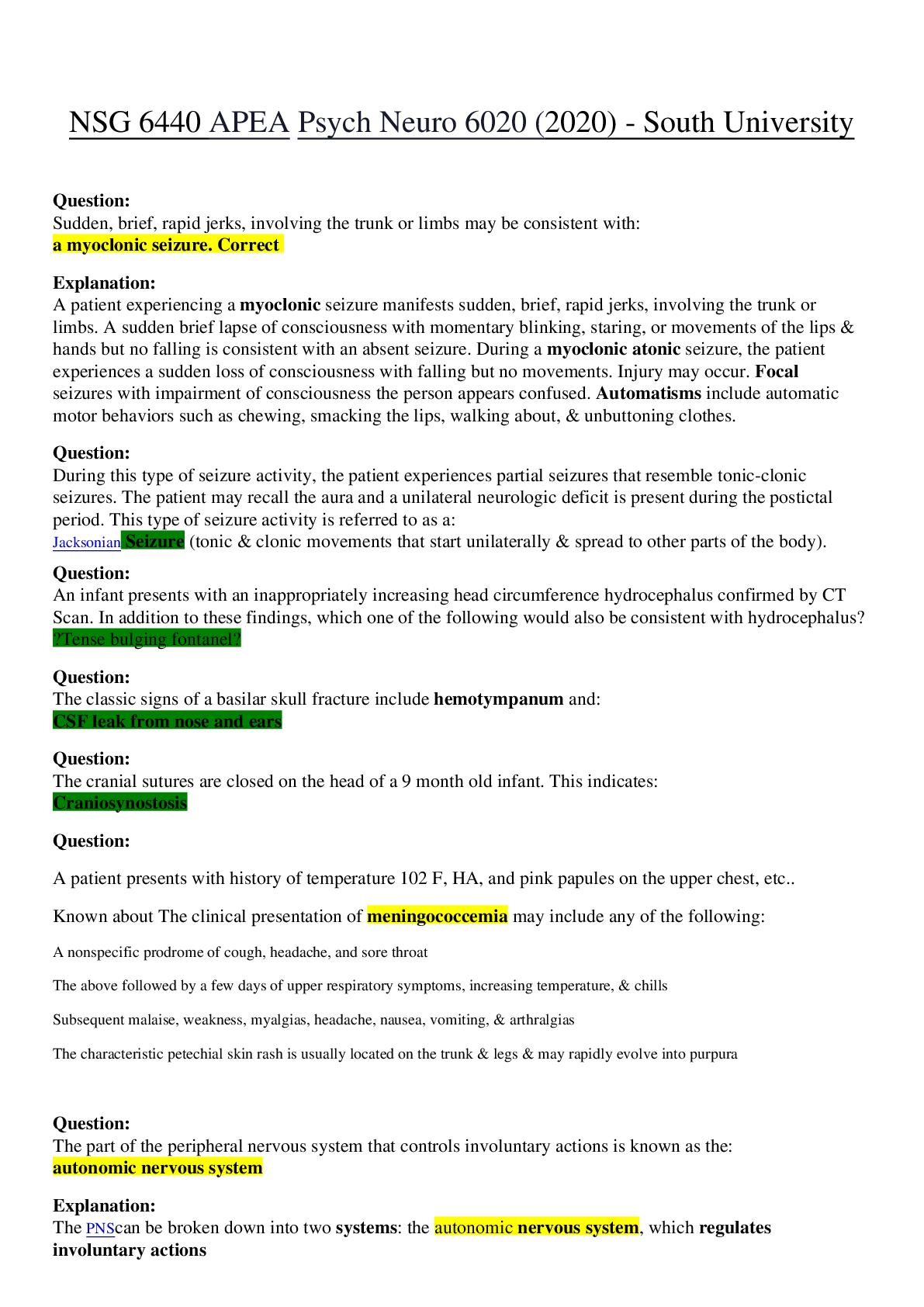
Reviews( 0 )
Document information
Connected school, study & course
About the document
Uploaded On
Jun 04, 2020
Number of pages
38
Written in
Additional information
This document has been written for:
Uploaded
Jun 04, 2020
Downloads
0
Views
36


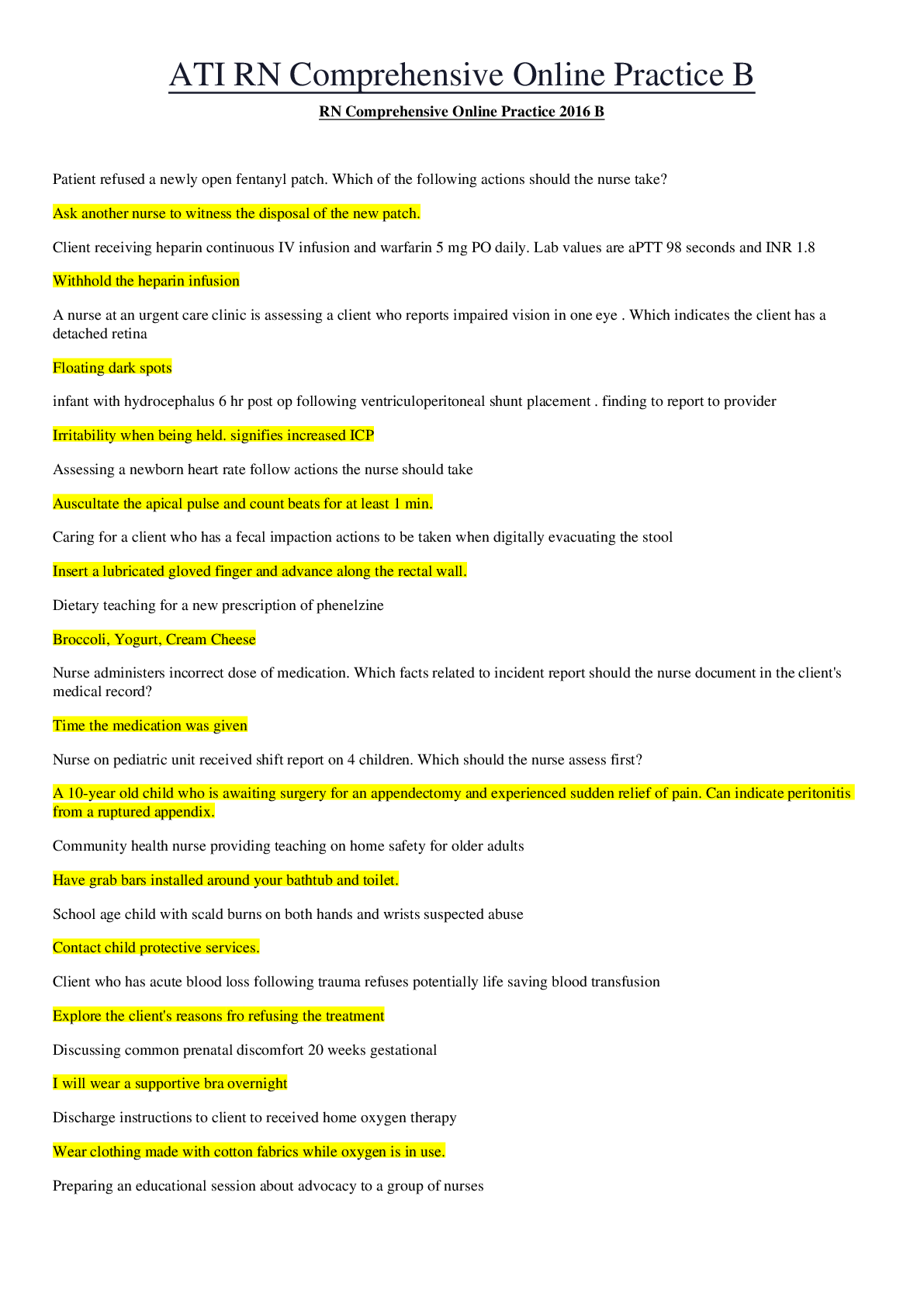
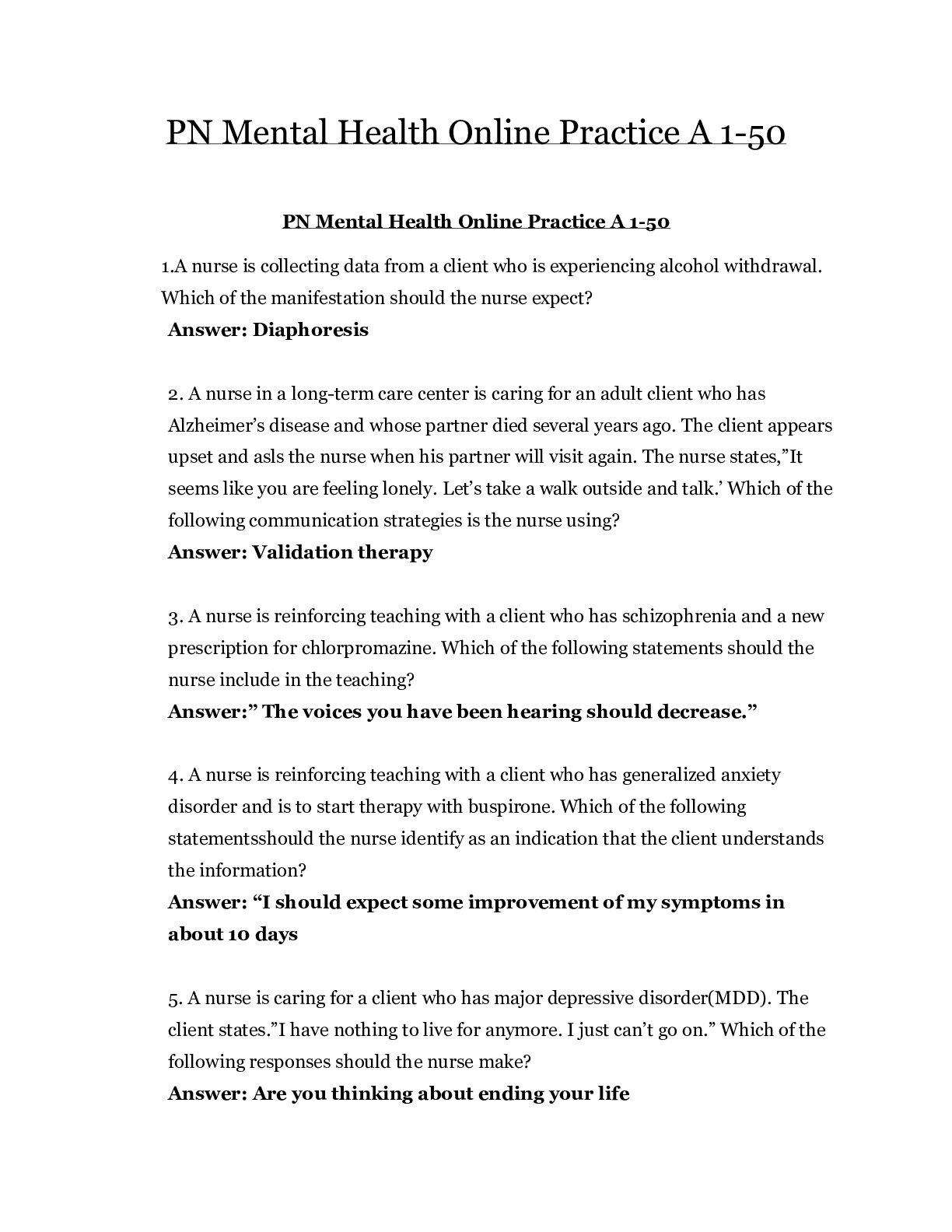
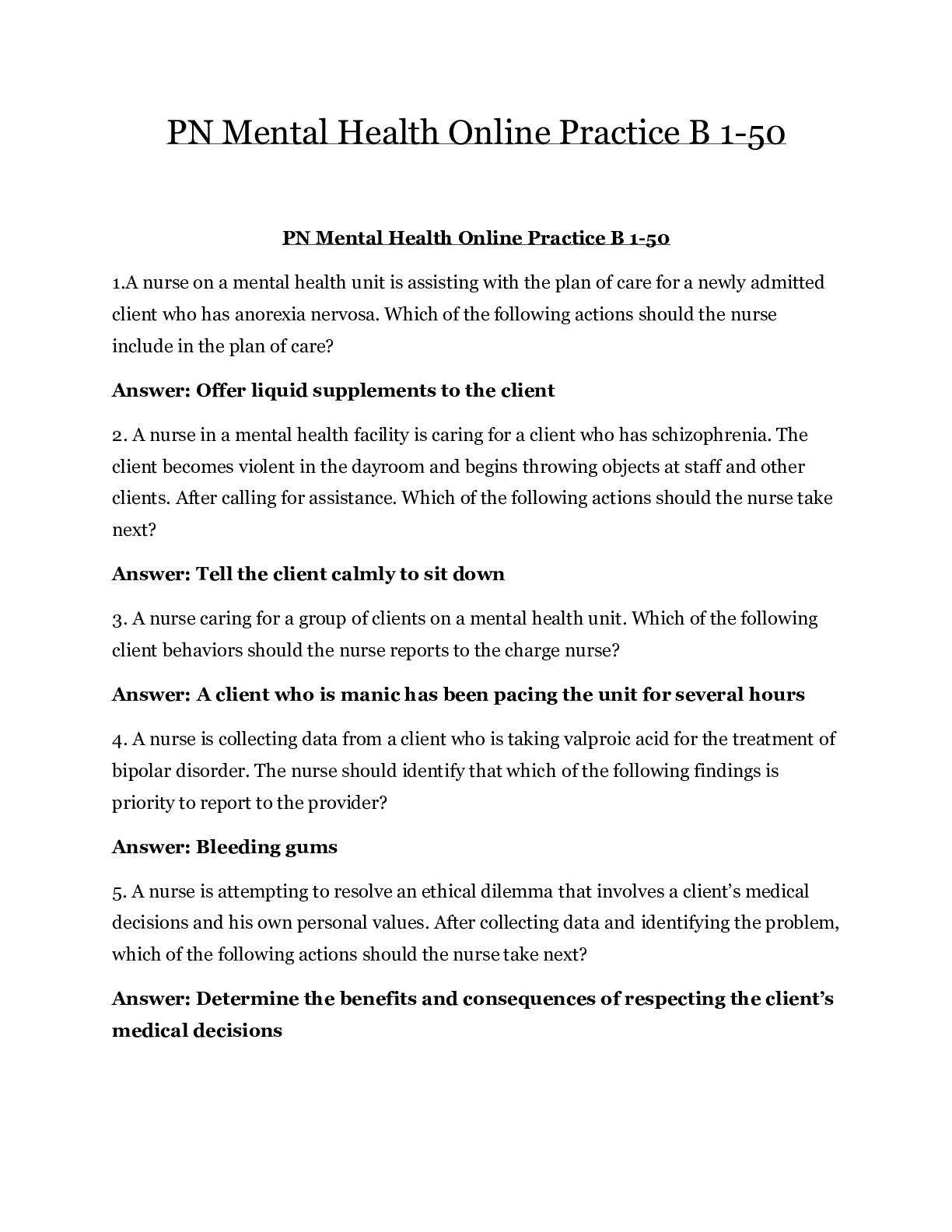
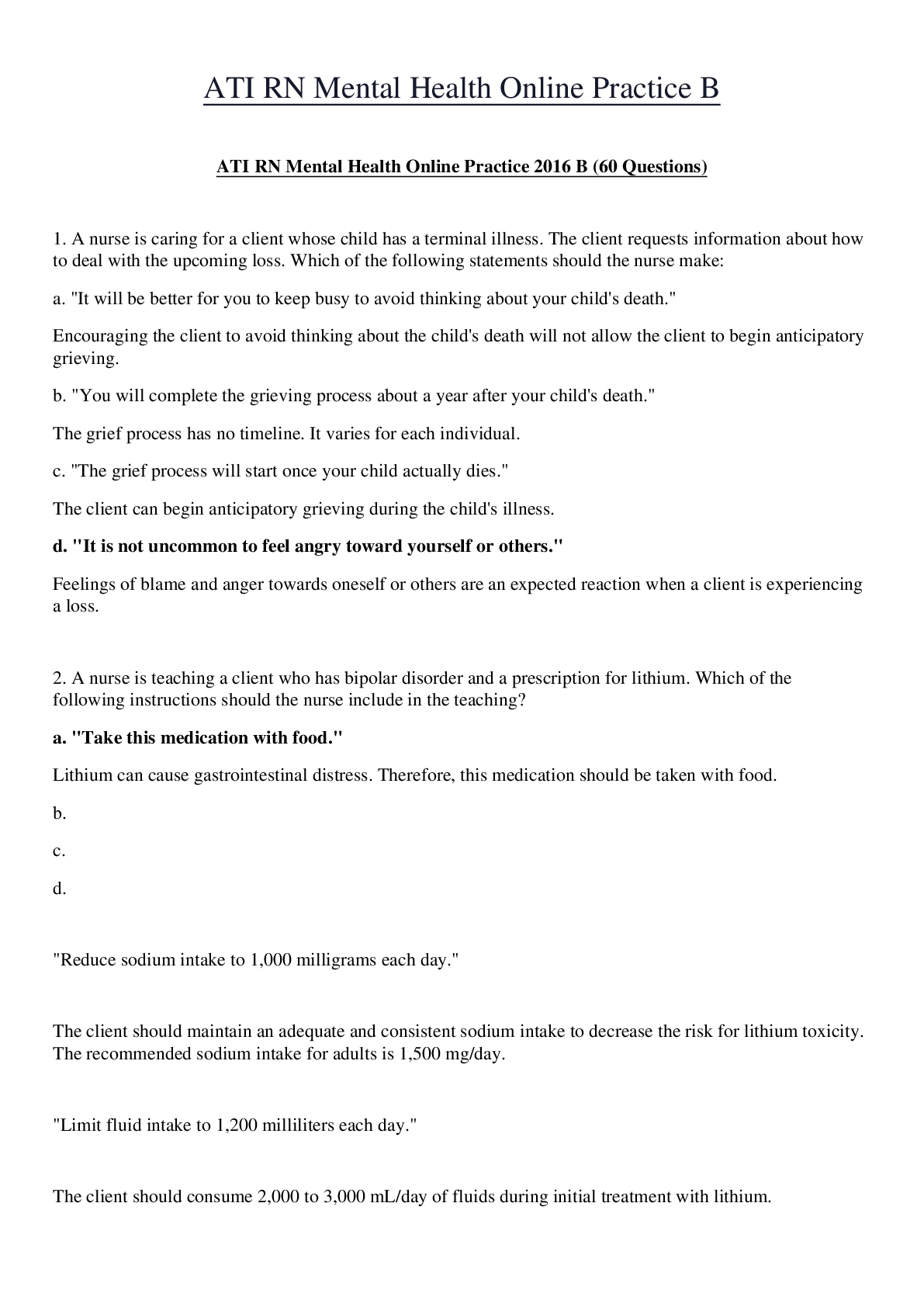


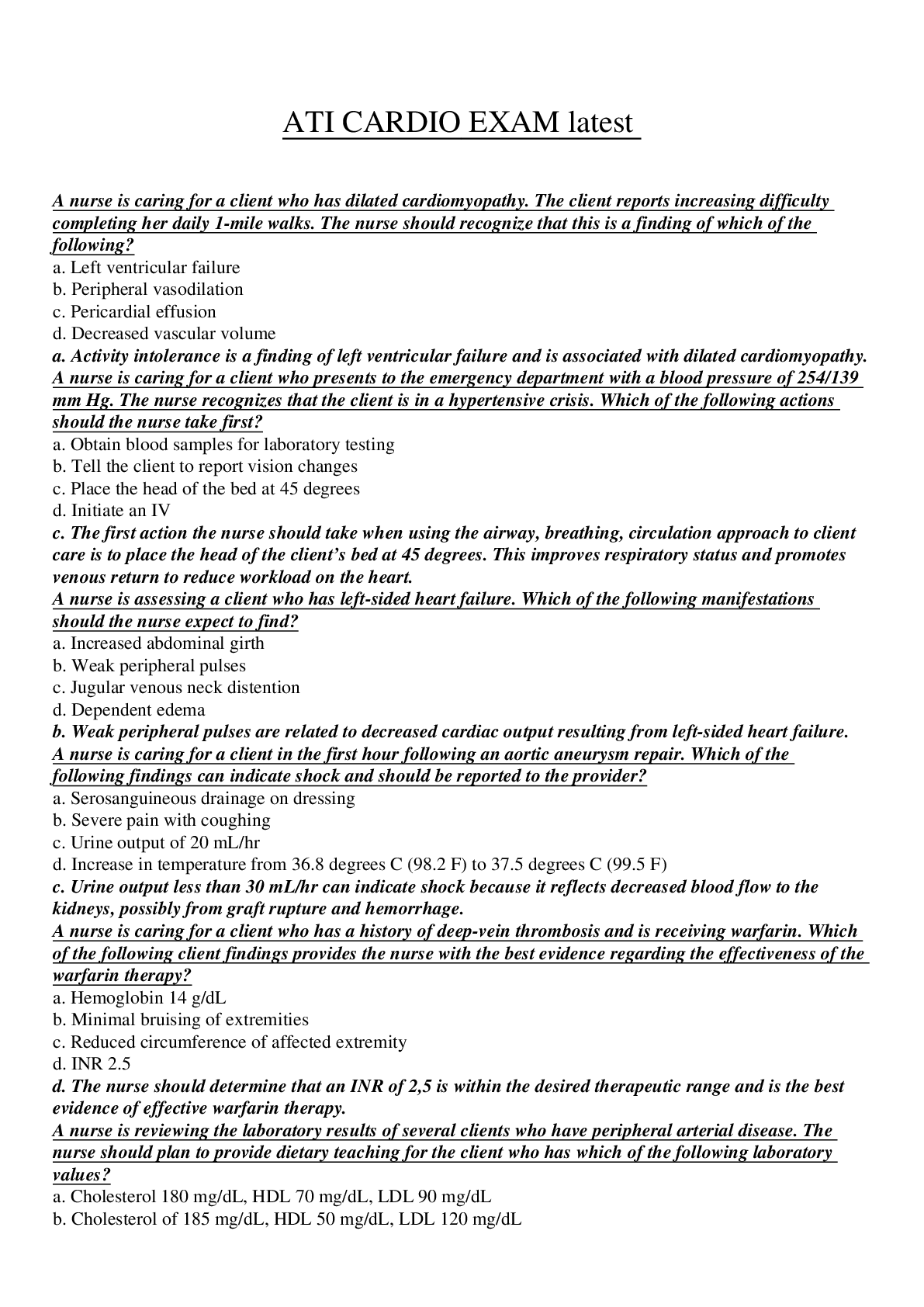
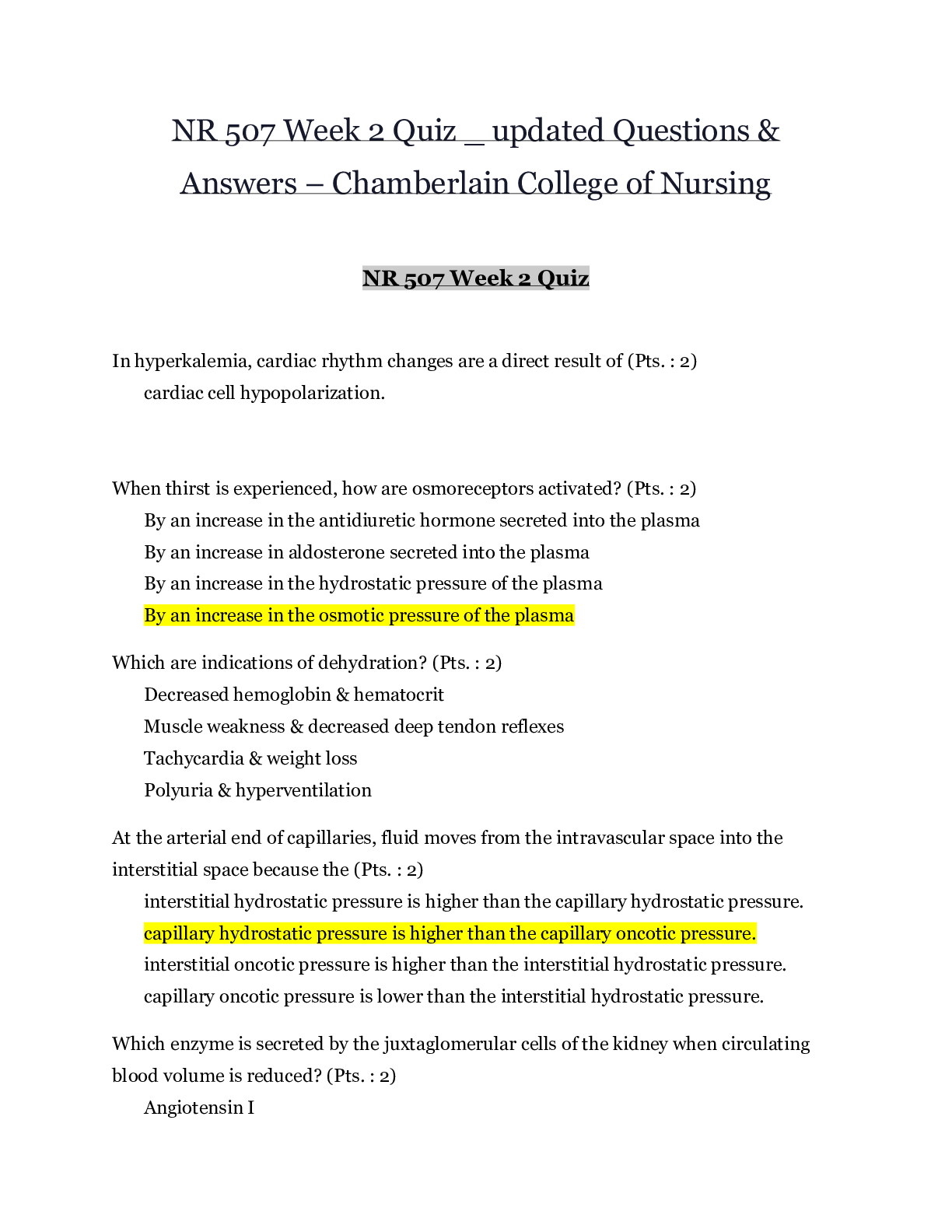
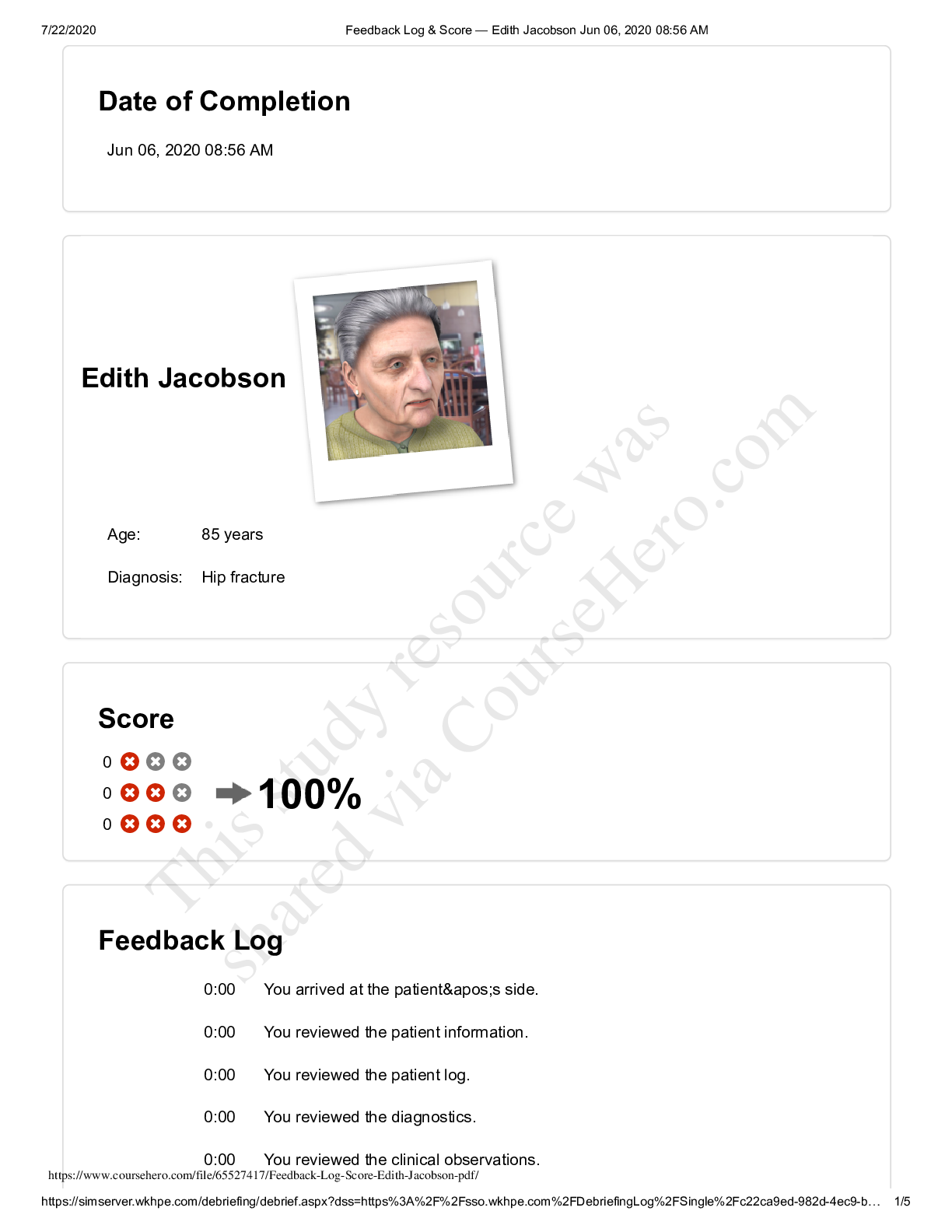
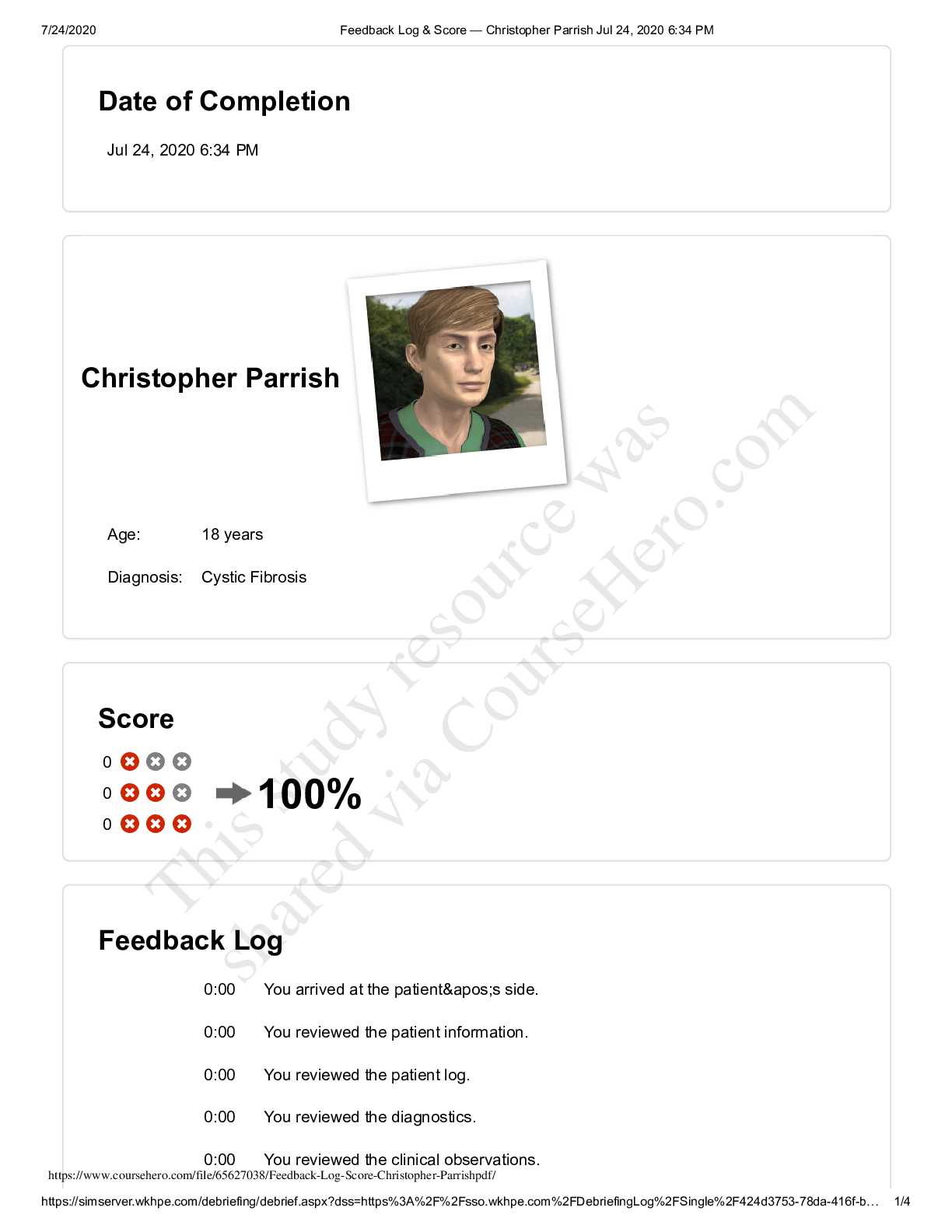
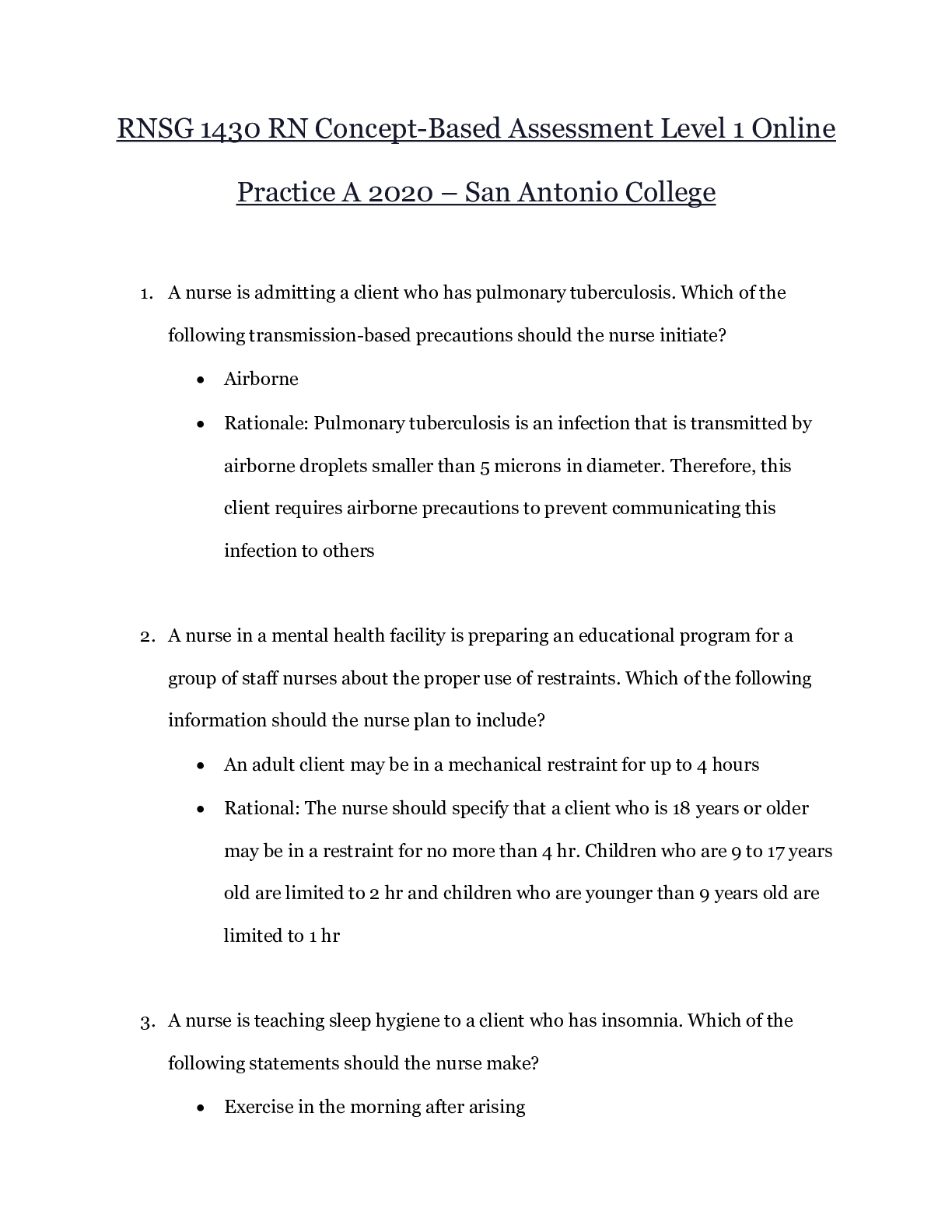


 – CHAMBERLAIN COLLEGE OF NURSING.png)
